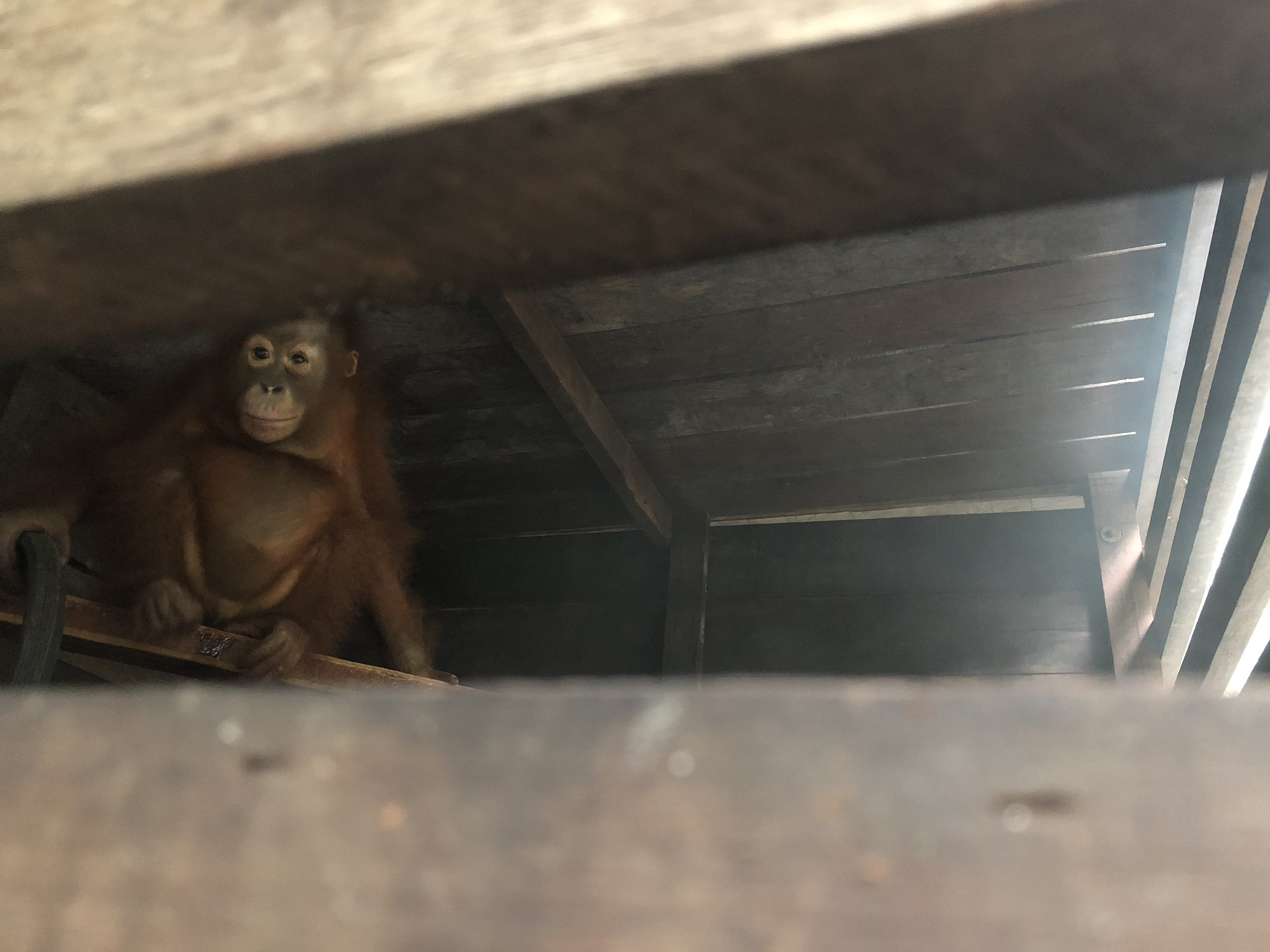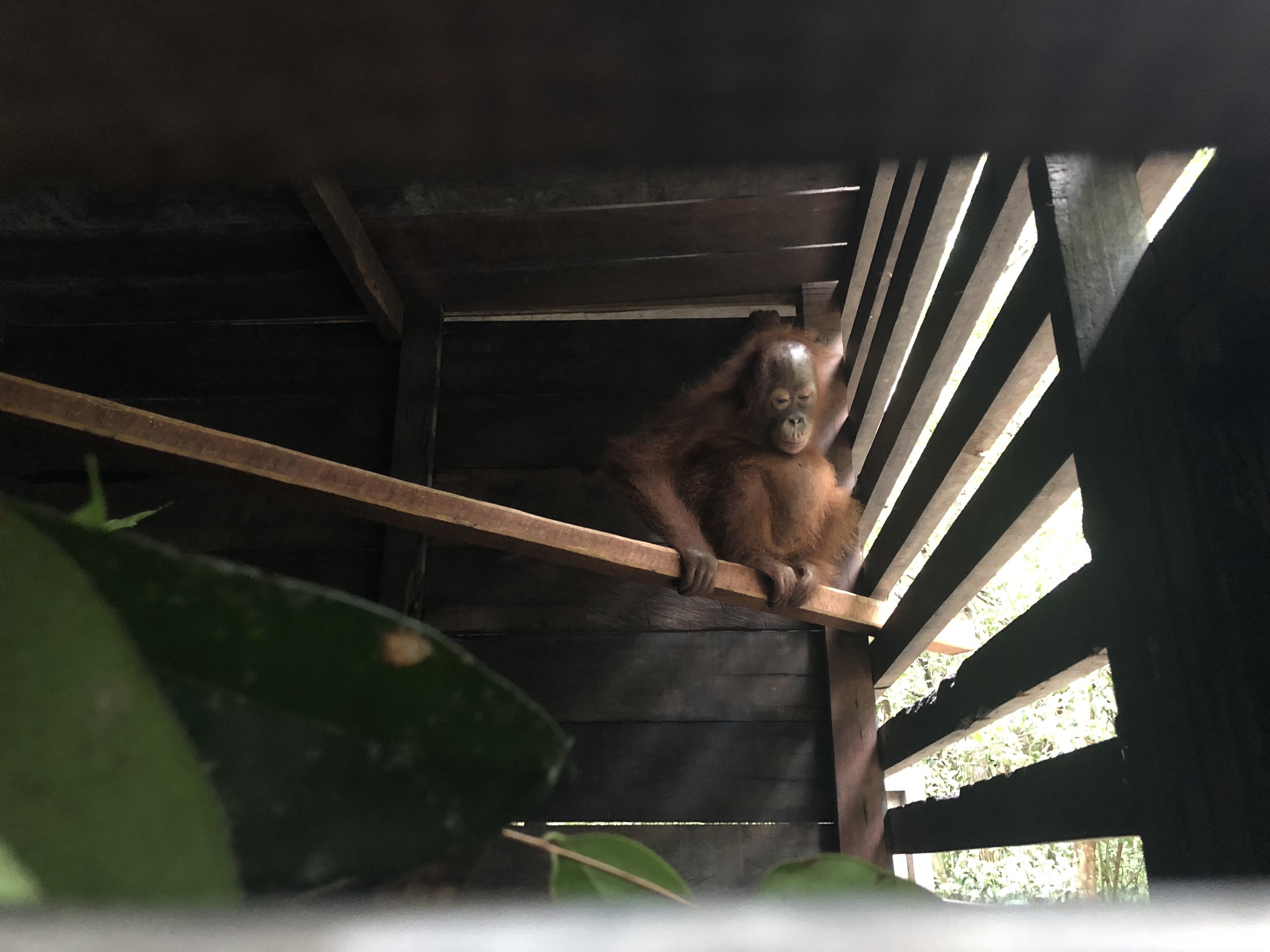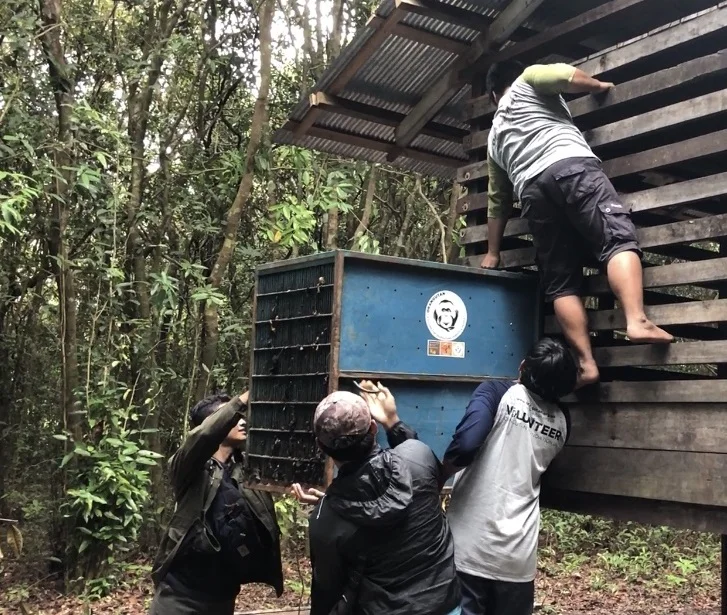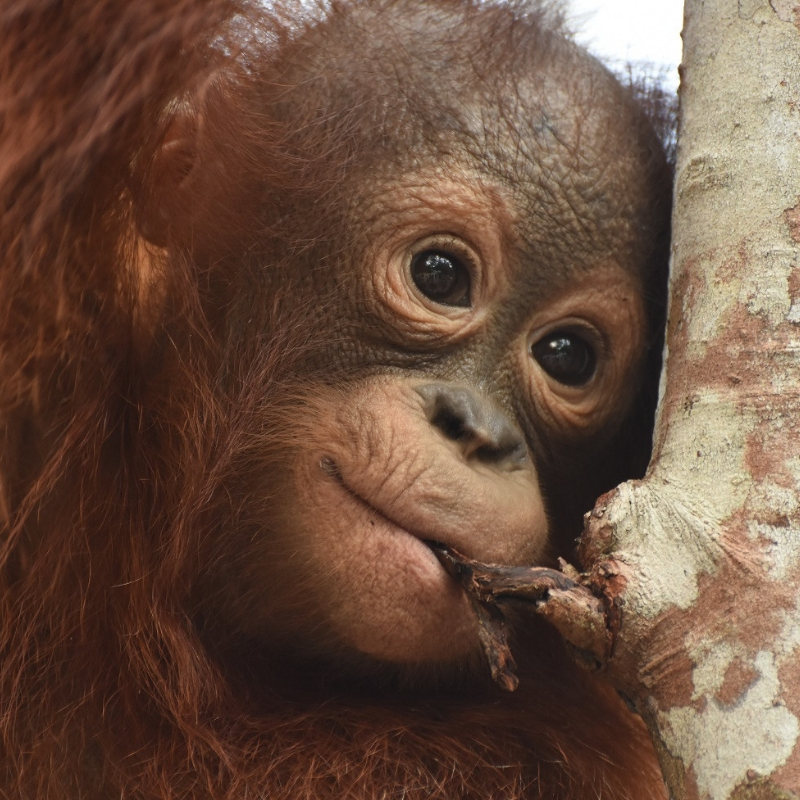There is never a dull moment for an Orangutan Foundation veterinarian… from rescuing sun bears to midnight visits to the local hospital as to not alarm residents, in this ‘In Conversation’, we catch up with Dr. Wawan and Dr. Dimas.
Orangutan Stories: Aan
Rescues are an essential pillar of our work as they save orangutans in need. The majority of rescues take place in oil-palm plantations or community land where orangutans can become stranded and unable to find suitable forest habitat in which to survive.
After medical check-ups, most adult rescued orangutans are able to be swiftly released back into a natural habitat that is protected such as the Lamandau Wildlife Reserve. However due to the injuries inflicted on female orangutan Aan, she is an unfortunate exception to this rule.
On her rescue from an oil-palm plantation in 2012, our team discovered that Aan’s left eyeball was missing entirely and under initial inspection, it was clear that she was malnourished and that her body was peppered with wounds from air rifle pellets. It was estimated that there were around 12 pellets visible in her skin but an X-ray would be required to find out the true extent of her injuries.
Incredibly it was revealed that Aan had in fact been shot over 100 times; 67 times on her arms, legs, and torso, and 37 on her head. It was truly remarkable that she was still alive.
Following a successful operation (below), 30 rifle pellets were safely removed from around Aan’s face whilst the remaining bullets were too deep under the skin and not doing any harm. She was then transported to the Lamandau Wildlife Reserve where she could recover and gather her strength.
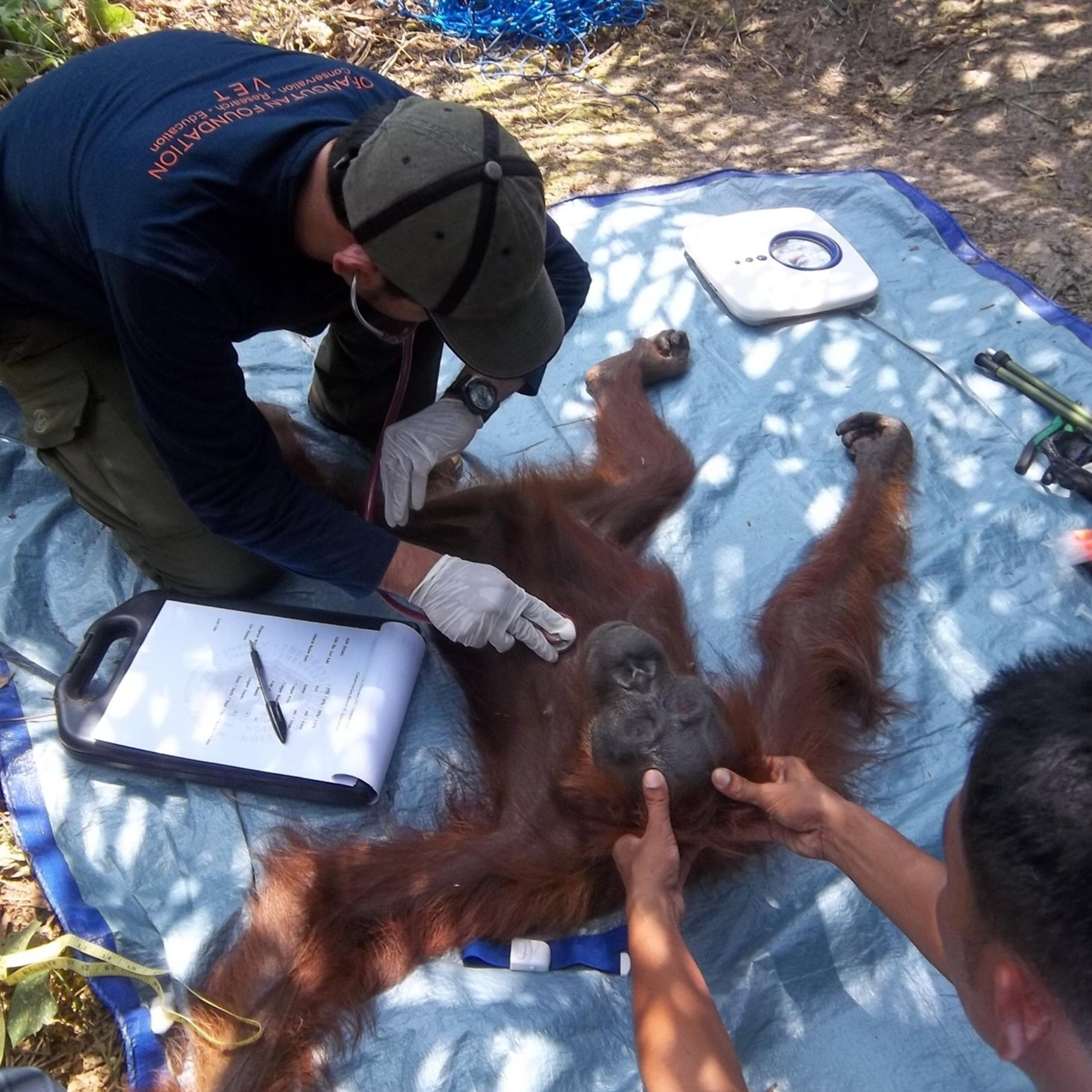
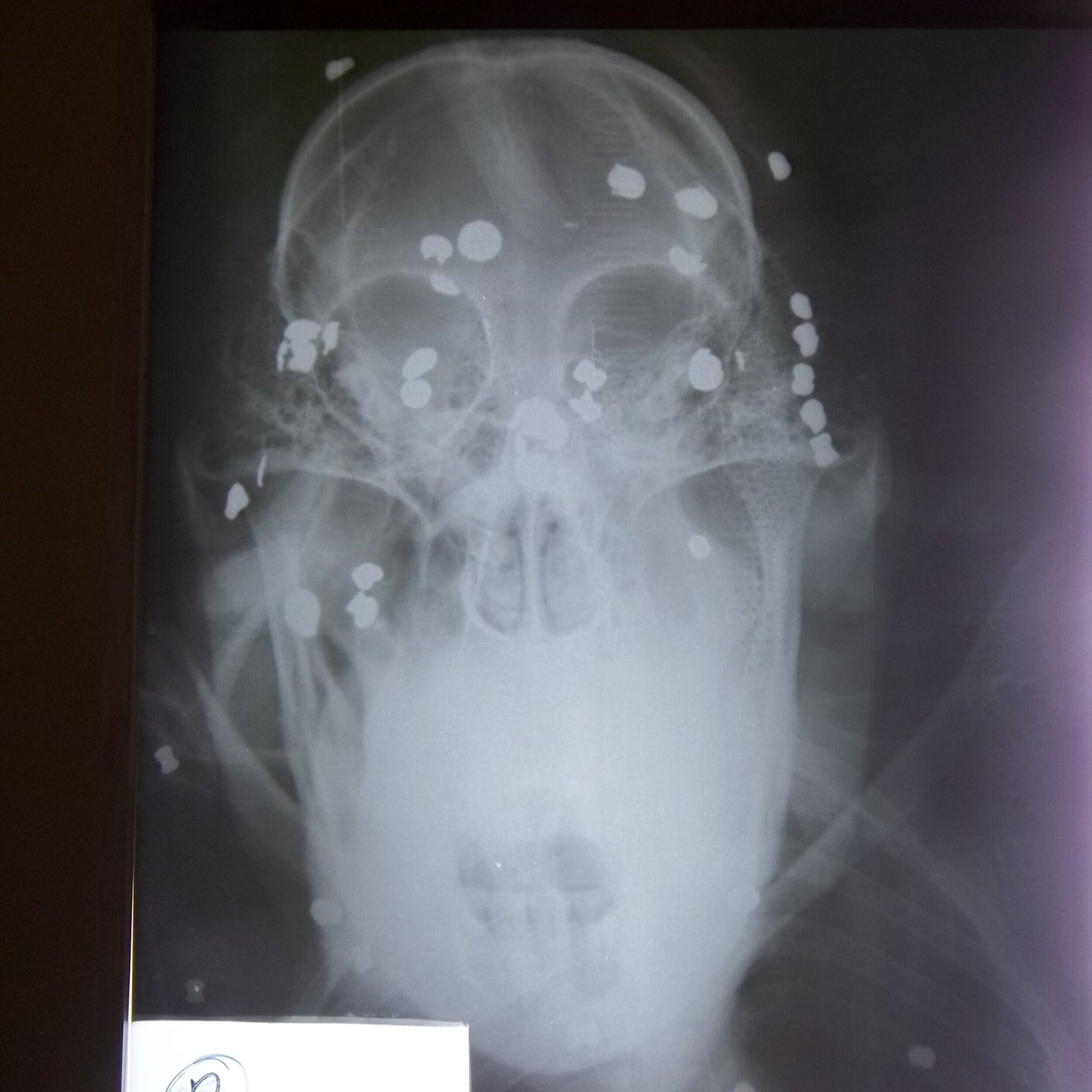
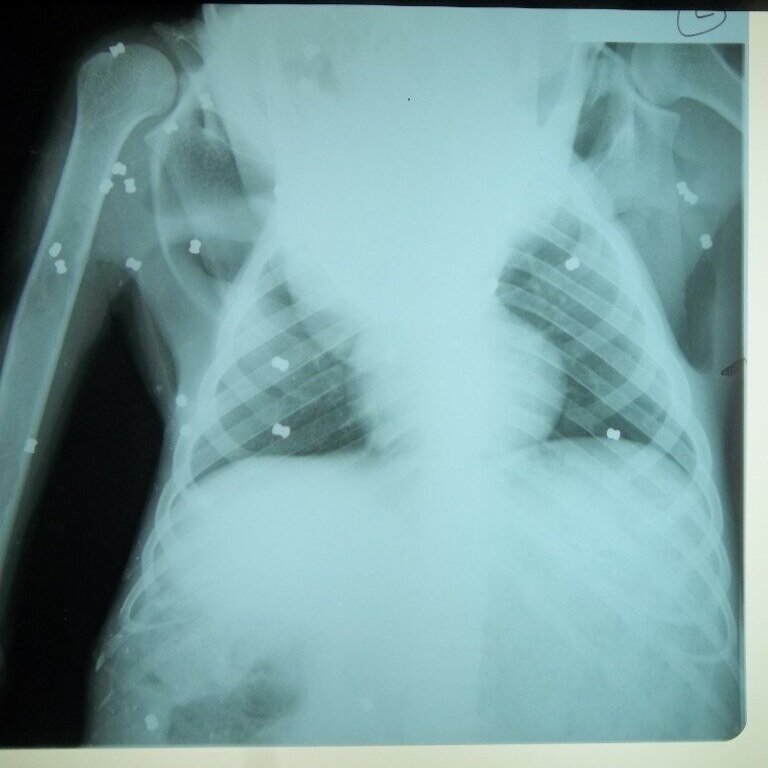
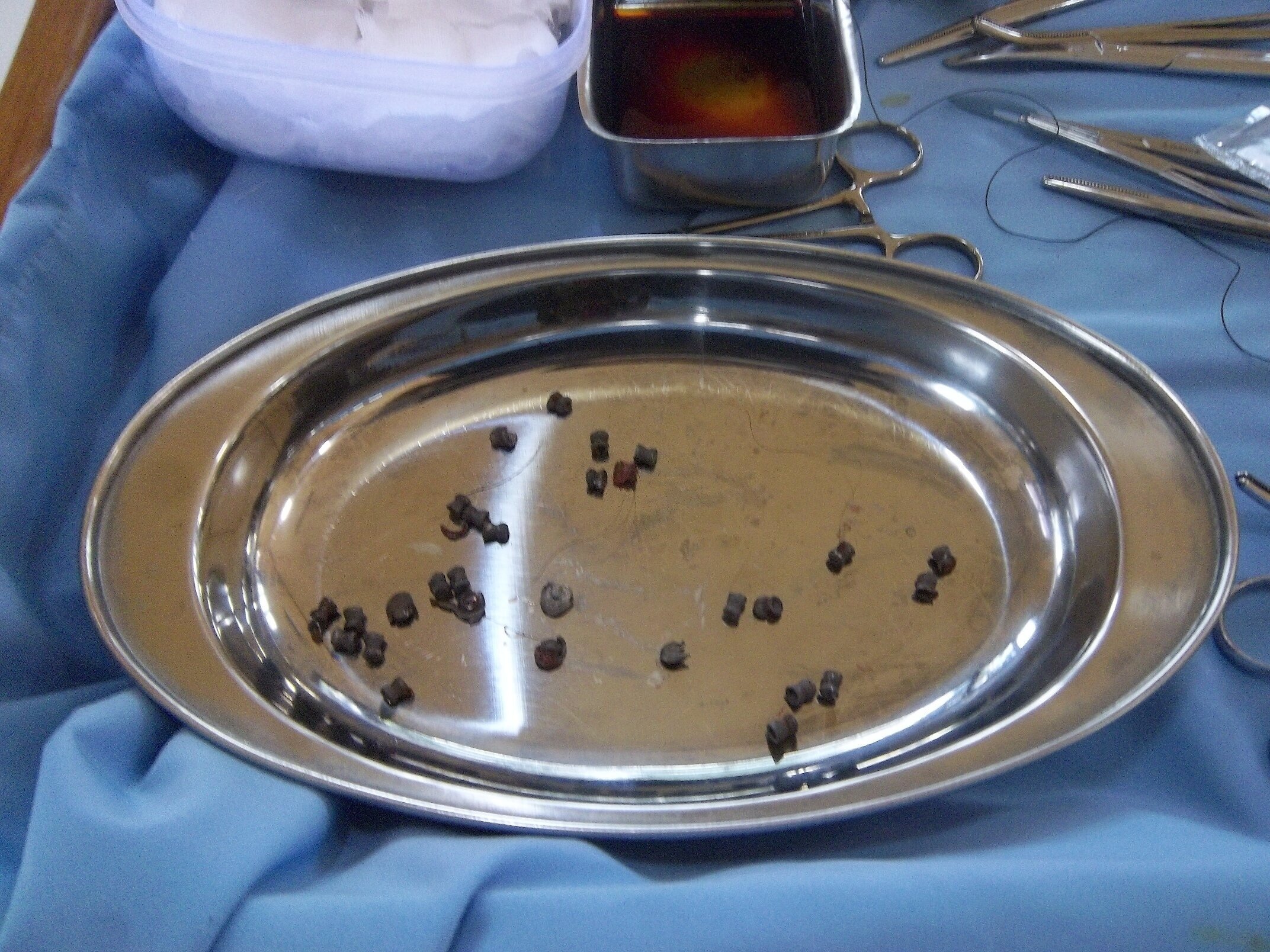

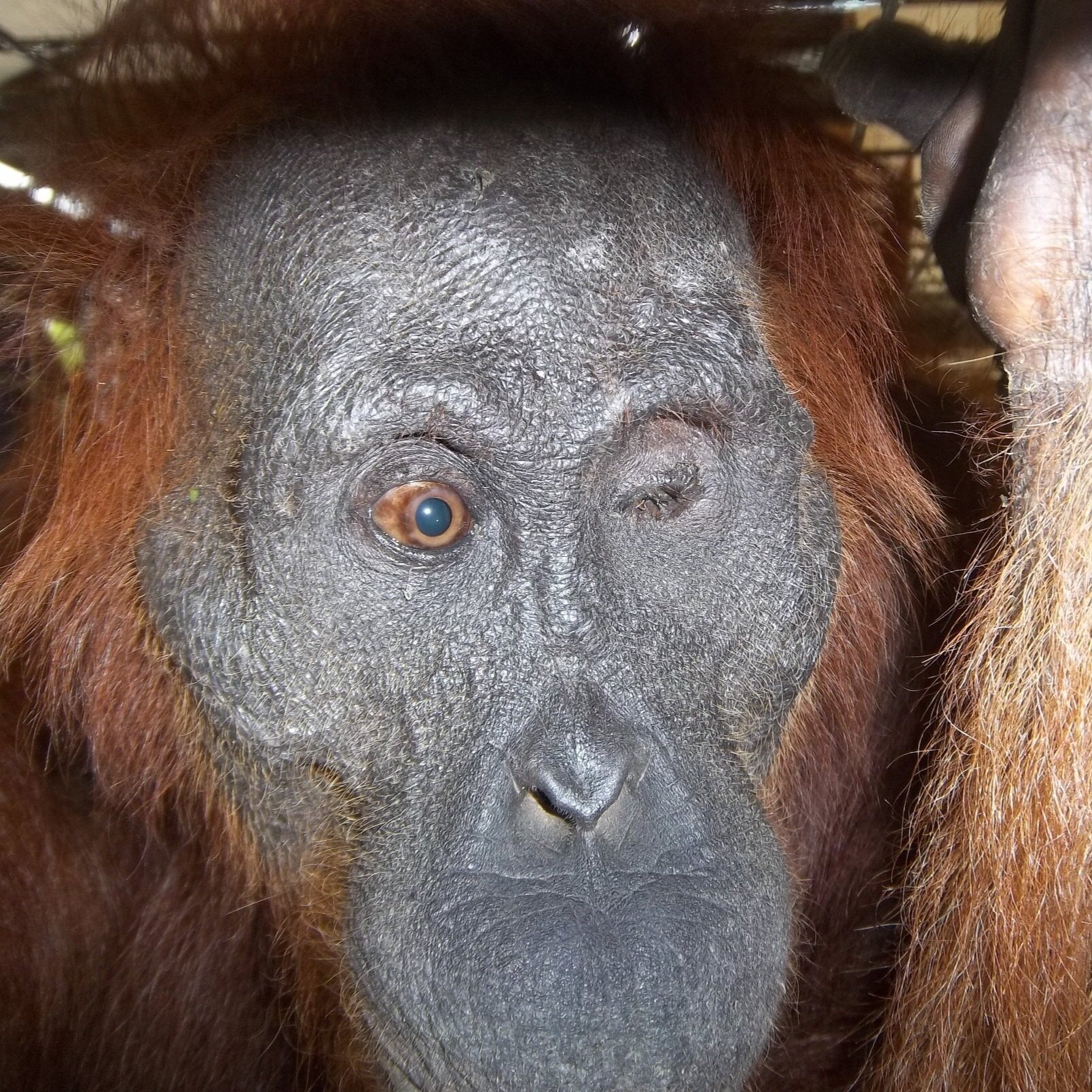
It soon became apparent that Aan’s right eye was also not responsive, and unless this sight could be restored, she would never be able to be released back into the wild for her own safety.
A ray of hope came in 2017 when a group of vets from the UK travelled to Borneo to operate on Aan’s remaining eye (below). At first there was cautious optimism as Aan’s cataract was removed and her optic nerve was still intact, however once she had come round from the anaesthetic, it appeared that unfortunately the damage she had previously sustained was too much.
Aan is now around 20 years old. In the wild she may have been raising her first or second infant, but instead she must be cared for as she cannot survive by herself. Our team continue to feed, stimulate, and provide enrichment by giving her tree branches and updating her enclosure at Camp Gemini, but it is difficult not to imagine how different her life would be in other circumstances.
Aan’s future has been determined by the damage inflicted to her by humas in the past, and we hope that she is the last orangutan in our care that cannot go back to where she belongs- the wild.
Orangutan Stories: Suwita
Biologically speaking, humans and orangutans are similar as we share around 97% of the same DNA. It could be said that orangutans also share comparable traits with us when it comes to parenting, as mothers teach their young essential skills for later life, and provide them with shelter each night.
As Orangutan Foundation’s founder and director/trutee, Ashley Leiman, says: “It is very special to watch a mother and infant together. I think the bond is so exceptional because orangutans are solitary. I’ve seen gorillas and chimps with offspring and the whole group is involved in the upbringing. Likewise elephants - if a calf falls over, all the aunties and extended family reach out to pick it up and get it back on its feet. With orangutans, all that care and teaching and relationship is condensed into the mother-infant bond. The mother’s eyes are never off the young”.
Suwita gives our team a rare glimpse of her young infant
Wild female orangutan Suwita has shown these crucial maternal characteristics over the previous weeks as she carefully looks after her new baby and appears to be showing the nurturing instincts you would expect for an orangutan mother’s first offspring.
Suwita was born in the forest near Camp Rasak in 2009 and of the four new wild orangutan mothers discovered recently within the Lamandau Wildlife Reserve, Suwita looks to be the most protective of her new baby.
Our field teams are continuously monitoring wild and reintroduced orangutans inside this protected habitat, and to help keep a visual record of their development, we try and take photographs from a suitable distance. Following careful observations of Suwita, it has now been discovered that her offspring is in fact male and has been given the name Samuel, but it hasn’t been easy to get a clear sight of the young primate.
Young Samuel is kept close as his mother feeds
Unlike the other recent orangutan mothers who almost appear to show off their newborns, Suwita is very protective to the extent that our team initially struggled somewhat in identifying the sex of her infant. When sat on a branch in trees Suwita rests her son securely on her lap to feed, and when travelling through the canopy she always makes sure that Samuel is safe and holding on tight, away from prying eyes.
Suwita is proving to be a doting mother to Samuel. It’s quite possible that her protective nature has developed from memories of her mother Sawit, but whatever the reason, it’s wonderful for us to observe a wild orangutan so caring for her first offspring.
Orangutan Stories: Sheila
Sheila is a female orangutan who was reintroduced to the Lamandau Wildlife Reserve in 2004 and is now one our regular visitors to Camp Gemini within the forest. Her story is one that mirrors many orangutans that have been translocated to the safety of this Reserve, and one that shows how suited this environment is for a healthy population of orangutans.
Sheila and her third offspring Sony forage for food in the trees.
Our field team have monitored Sheila’s progress since her arrival into the forest at around five years of age and recorded all of the major events in her life. From the unfortunate passing of her one-year-old son Shola in 2007, to the births of her daughter Sakura in 2008 and son Sony in 2014. Sakura is now at an age where she can roam independently in the forest, but young Sony is still spotted at camp shadowing his mother from time to time.
Sakura (left) is now an adolescent exploring the forest independently, while Sony (right) is becoming more self-reliant but still stays in close proximity to his mother.
While all three orangutans live entirely in the wild, they are observed by our team when they come near to camp to ensure that they remain in good health. In recent months however, Orangutan Foundation staff saw that Sheila’s throat sack had grown bigger, an unusual occurrence for female orangutans. Males commonly have larger throat sacks, acting as echo-chambers as they produce their resonating long-call through the forest, but typically females do not.
Following some deliberation it was the decision of our vet Dr Dimas that the best course of action would be to observe Sheila more closely and anesthetise her so that her throat could be suitably checked. One afternoon with Sony playing in a nearby tree, our team were able to carefully sedate Sheila and begin their examination.
Generally Sheila appeared to be in good health, however a syringe would need to be inserted into her throat sack to check whether it contained excess air or fluid which may need releasing. In reality though, it turned out to be neither of these things. Instead it was discovered that Sheila had an extra layer of fat which fortunately is not suspected to be harmful to her wellbeing. Dr Dimas was happy to give Sheila a supplementary vitamin injection and clean bill of health to go back into the forest.
Her progress will continue to be monitored, but it is tremendously reassuring for our team to know that orangutans like Sheila in this forest are prospering in a protected natural habitat.
Two rescued orangutans returned to the wild
Two critically endangered orangutans are now back in the wild, where they belong, thanks to the dedicated work of the Orangutan Foundation’s team and the Natural Resources Conservancy Agency of Central Kalimantan (BKSDA).
Both orangutans were wild born but tragically ended up orphaned and rescued by Orangutan Foundation. Shifa was rescued from being kept as a pet in September 2016, when she was only 2-years-old. Panglima, was rescued at the end of March 2019, from community forest, he is thought to be about 5-years-old but showed extremely wild behaviour (read more about his rescue).
Shifa rescued in September 2016
Habitat loss is forcing wild orangutans into closer contact with humans. We can’t say for sure what happened to the mothers of Shifa and Panglima but it is most likely they were killed, because they were considered as pests. As an infant, Shifa would have been clinging to her mother and so she was taken to become a pet. Panglima, being older and more independent, must have been apart from his mother when she was killed.
Panglima rescue by Orangutan Foundation and Wildlife Department (BKSDA) Central Kalimantan
Shifa was taken to the 158,000-acre protected Lamandau Wildlife Reserve, Central Kalimantan, Indonesian Borneo. She lived at Camp Buluh, one of five post-release monitoring sites in the reserve, which she shared with another orphaned orangutan, Okto. The two young orangutans were great playmates and Okto helped Shifa to adjust to her new life.
Okto (left) and Shifa (right)
Shifa always displayed very wild instincts and, as she got older, these became stronger and more evident. Increasingly she would go off exploring the surrounding forest and was reluctant to return to her enclosure at night.
Shifa in her nest and increasingly reluctant to go back into her enclosure.
It was decided to release Shifa before she released herself! When an orangutan is fully released back to an independent life, Orangutan Foundation staff follow the individual for up to two weeks to ensure the orangutan is able to survive. Ashley Leiman OBE, Orangutan Foundation Founder and Director/Trustee, was present for the two releases and was encouraged to see how readily both orangutans clambered up into the trees to begin their new life.
As soon as the transport cage door opened, Shifa shot straight out and climbed up the nearest tree
Shifa and Panglima have had to overcome massive hurdles early on in their life. Our challenge now is to ensure the rest of their life is spent in the wild. We are doing this by safeguarding their globally important forest habitat in Lamandau Wildlife Reserve. Orangutan Foundation actively monitor the reserve with a network of guard posts and regular patrolling to prevent illegal activities from destroying the forests and harming wildlife.
Why play is important for young orangutans
The orphaned orangutans in our soft-release programme in Lamandau Wildlife Reserve, Central Kalimantan, Indonesian Borneo, are taken out to play in the forest every day. Play-time is crucial for the young orangutans as it allows them to watch and learn from each other. Together, they find food and build nests. Play helps to build up their strength and climbing skills. This video, taken recently, show’s Mona “at home” in the forest. Just watch how she uses her hand-like feet and every-which-way hips to move with such ease and confidence.
The next video clip shows Nyunyu eating bark with Mona (above right) watching and joining in.
Rescued orangutan soon ready for release back to the wild
When Panglima was first rescued he wouldn’t use the tyre swing or browse in his enclosure - the team looking after him felt sure he would but it would take time for him to adapt to his new surroundings. They were right!
Panglima, a rescued wild Bornean orangutan is very wary of humans.
These images show Panglima using the swing and he gathers up browse (the branches and leaves he is given) and makes a nest.
Panglima using his tyre swing and browse
He eats plenty of fresh fruit and is active and healthy. He is still wary of humans and moves away when someone approaches the enclosure, but this is behaviour we want him to retain.
Panglima is a wild orangutan and though he is quite young he will be released back into the wild in June. He’ll be followed by our post-release monitoring staff. If he needs it he will have access to supplementary fruit. Watch this space for an update on his return to the wild.
Though still young Panglima is very wild and he will be better off living in the forest.
Update on rescued 5-year-old wild orangutan
Yesterday our vet, Dr Dimas, and our reintroduction manager, Mr Azhari, visited Panglima, the five-year-old wild orangutan, who we rescued last week. Panglima is temporarily being kept in isolation at Camp Siswoyo, in Lamandau Wildlife Reserve.
The staff at Camp Siswoyo provide leaves and branches every day as an enrichment. He doesn’t use the tyre swing but we’re sure he will as he adapts to his new surroundings. Panglima rests on the enclosure floor but as soon as anyone approaches he climbs to the top of the enclosure. He is wild and it is good that he is wary of humans, which is something we want to maintain. He is eating well and this is also a positive sign.
Young orangutan rescued
Yesterday, we rescued a young orangutan, aged approximately 5-years-old. Sadly, the mother was absent, we don’t know what happened to her but most likely she has died, mother orangutans would not readily abandon their offspring.
Tranquillised orangutan, named Panglima
The Wildlife Rescue Unit (WRU) team was made up of the Central Kalimantan Wildlife Department (BKSDA) and Orangutan Foundation. The Wildlife Department had received reports about an orangutan seen in a community orchard. The rescue team drove 45 minutes from the town of Pangkalan Bun to the reported location in the Pangkalan Lima area, South Arut District.
Orangutan nest high up in the tree
When the team arrived they saw two nests in one tree, but there was no sign of an orangutan. After a while the team decided to return to Pangkalan Bun. In the afternoon, the team received another report about the orangutan and so they returned. This time they saw a young orangutan very high up in the trees. The team decided to follow the orangutan until it nested in hope they could get a clear shot with the dart gun. Unfortunately they couldn’t and because it was getting dark and unsafe they decided to return very early the next morning, when hopefully the orangutan would still be in his nest.
Preparing the dart gun to tranquillise the young orangutan
Climbing up the tree to rescue the sedated wild orangutan.
The next morning, in the torrential rain, the rescue team arrived at the nest location at 4.30am. The orangutan was found above a nest, not far from where they had left him. The dart gun was prepared so that the orangutan could be tranquillised. They managed to get a clear shot and the orangutan fell into its nest. One of the rescue team climbed a 10-meter tall tree and managed to carry the orangutan down.
The Orangutan Foundation vet immediately conducted an examination and the orangutan was male, weighing approximately 15kg and was estimated at around 5-years-old. Our vet, Dr. Dimas Yufrizar, took blood samples for laboratory tests and gave injections of multivitamins and antibiotics.
The orangutan has been named Panglima (relating to the rescue location) - giving orangutans names helps the field staff with post-release monitoring and communications.
Tranquillised orangutan being examined by Orangutan Foundation vet
Panglima was transported to the Pangkalan Bun BKSDA SKW II office where he is being kept temporarily in a holding cage. Hendra Gunawan, Orangutan Foundation Program Manager said BKSDA have requested that the orangutan be translocated to the Lamandau Wildlife Reserve, a protected area. Before release, Hendra said Panglima will be isolated until his blood tests return and then habituated for three months. His condition will be monitored by the Orangutan Foundation vet and field staff.
The rescue team are confident that Panglima’s release into the reserve will be successful and that he will go on to live a wild and safe life in the Lamandau Wildlife Reserve.
Support our work and join Orangutan Foundation today.
Orangutan Foundation vet's surprise river encounter
Orangutan Foundation’s vet, Dr Dimas Yuzrifar and our Reintroduction Manager, Pak Azhari, visit the post-release orangutan monitoring camps, in the Lamandau Wildlife Reserve , Indonesian Borneo, on a weekly basis to check up on the orangutans, who live there. Last week, they had an unexpected encounter…
Play time! Okto and Shifa at Camp Buluh January 2019
Their first stop was Camp Buluh, where orphaned orangutans Okto and Shifa were out playing in the trees. Camp Buluh staff said that they were both healthy and active and because they had been given their multi-vitamin and anti-worming injections the week before, they were left to carry on playing.
Okto having his regular boost of essential minerals and vitamins.
Second stop, Camp JL - young orphaned orangutans 5 year old Nyunyu (left) and 3.5 year old Mona (right) playing in the trees.
The next stop was Camp JL to check on Adib and see how his arm was healing and to see Mona, Nyunyu, Timtom and Boy.
Camp JL- 3.5 year-old female orangutan Timtom, January 2019.
The only access to the release camps is by river and so Dr Dimas and Pak Azhari headed off to their final camp of the day, Camp Gemini . Half way through their journey they came across a longboat with an unexpected passenger!
Female orangutan, Sheila in Camp Gemini’s longboat.
Adult female orangutan Sheila and her infant Sony, had untied and taken the longboat, belonging to Camp Gemini, and were using it to cross the river. Sheila was in no hurry to leave the boat but eventually they climbed out onto the river bank and up into a tree. Azhari and Dimas managed to tow the longboat back to Camp Gemini, where the relieved team of Camp Gemini staff were waiting. They’re devising another way to prevent these highly intelligent great apes from taking a boat again!
News from the orangutan monitoring release camps, Lamandau Wildlife Reserve
Orangutan Foundation vet, Dr Dimas, has kept a close eye on the healing of Abid’s broken arm. Two-year-old orangutan Adib fractured his arm on 16th December after he fell from a tree.
Two-year-old orangutan Adib’s arm is healing well and he now has a strong grasp.
We are delighted to report that Adib can now grasp the wood in his enclosure and he’s started to play and swing around inside. He shows no sign of pain when his hand is held, and he has a strong grip on the camp staff when they pick him up. Due to his young age his bones will heal quickly and we are sure he’ll make a full recovery and be back in the trees at Camp JL in a week or two.
Okto enjoying the high-water levels at Camp Buluh!
There is no forgetting it is the rainy season in Borneo! Okto and Shifa are certainly taking full advantage of the high-water levels at Camp Buluh.
Orangutan Shifa joining in too.
Shifa is progressing very well and the Camp staff are finding it increasingly difficult to return her in the evenings from the forest back to her enclosure. This is a very positive sign and we are hopeful that we will soon release Shifa from soft-release to an independent life into the wild. Watch this space…
With plenty of fruit in the forest, not many of the post-release orangutans come for supplementary fruit. However, Bangkal, the dominant male orangutan at post-release monitoring Camp Gemini has been seen in the forest. Read more about Bangkal’s extraordinary survival story by clicking here.
Donate to support our work in the Lamandau Wildlife Reserve, Indonesian Borneo.
Young orangutan Adib falls and breaks his arm.
Young orphaned orangutan Adib fell and broke his arm
Poor little Adib has broken his arm.
As usual, he was playing in the trees at Camp JL but, whilst swinging from one tree to another, he missed and fell to the ground.
Camp staff suspected he had broken his arm as he wouldn’t use it.
Our vet decided to x-ray Adib’s arm, which revealed a small fracture on his right ulna.
We are not worried about this impacting Adib’s future in the wild. At his young age, bones regenerate rapidly.
Adib’s arm has been fixed to ensure it heals correctly and he has been given anti-inflammatory to reduce swelling and multivitamins and calcium supplements to aid the healing process.
For the next few weeks Adib will have to stay in a smaller enclosure, which will help him to rest his arm.
Meanwhile, he’s being given some tender loving care and special treats such as banana porridge!
We are sure it will not be long before Adib is back in the trees playing once again with the other orangutans in our soft-release programme, in the Lamandau Wildlife Reserve, Indonesian Borneo.
Orangutans with a second chance of being wild
This blog post brings you news on some of the orangutans who we are caring for or who have been released back into the wild.
Orphaned orangutan Mona November 2018
This is little Mona, she's been in our care since March 2017 and she's making excellent progress. She always seems to be photographed with her something in her mouth! One day she'll be fully released back into the wild. We are trying to ensure this "wild", the 158,000-acre Lamandau Wildlife Reserve, Indonesian Borneo, stays protected.
This sweet photo of Okto and Shifa, shows Shifa when she had been recently rescued, two years ago. She initially had problems with hair loss, possibly as a result of stress but this has now regrown into a beautiful coat of hair!
This Ketty, who was released back into the wild in 2017 and above you can just about see infant orangutan Ariel, Ketty's "adopted sibling"! It is incredibly rewarding when we hear about or see again an orangutan who has been given a second chance to be free in the wild.
Ketty was born in the wild to Korin, a reintroduced orangutan to the Lamandau Wildlife Reserve. Korin sadly disappeared in 2013 and our staff found Ketty alone, only a few years old. In 2017, after 4 years of being cared for by us Ketty was released back into the wild. She was soon adopted by adult female orangutan Acuy and her infant Ariel and we often see all 3 together, Ketty playing with Ariel, while Acuy watches on.
Rescued and released orangutans of Lamandau Wildlife Reserve
Our vet, Dimas and programme manager, Iman, have been on their weekly visits to the orangutan release camps in the Lamandau Wildlife Reserve, Central Kalimantan, Indonesian Borneo. They check on the orphaned young orangutans and ensure the good health of the released orangutans. Their journey took longer than usual because the river levels are very low, due to lack of rain. Instead of travelling by speedboat it was completed in a shallow longboat (or klotok, as they’re called in Indonesia). Our youngest orangutans are cared for at Camp JL and include Timtom, Nyunyu, Adib, Mona (photo below) and Boy. Dimas gave them their multivitamin injection to keep them healthy but they are all well and active.
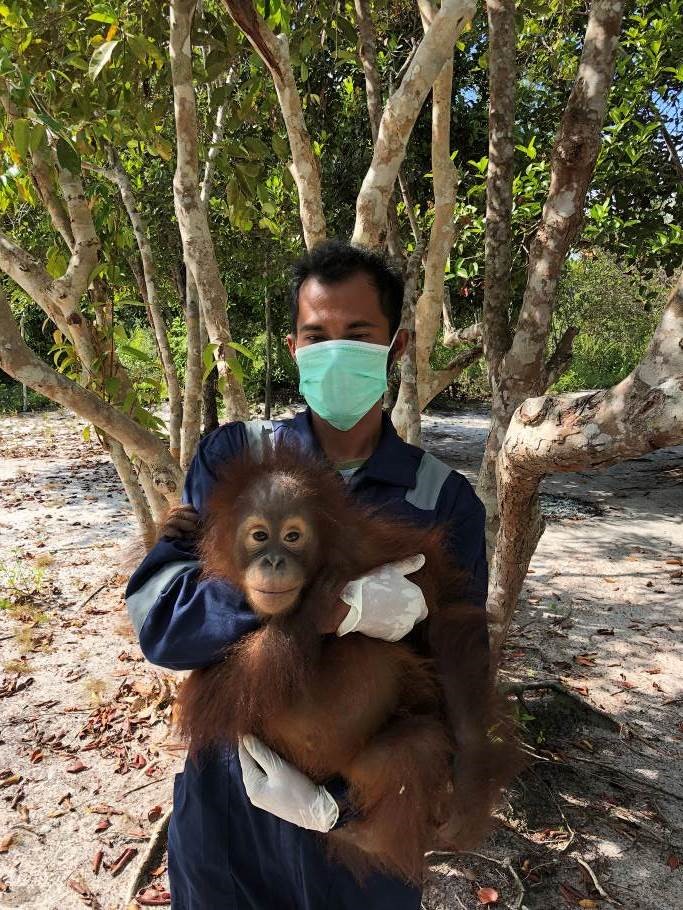
In the afternoon they continued by longboat to Gemini Camp. This is where blind orangutan Aan lives. Aan was shot and can never be returned to the wild. Her enclosure recently had new ropes (see below).
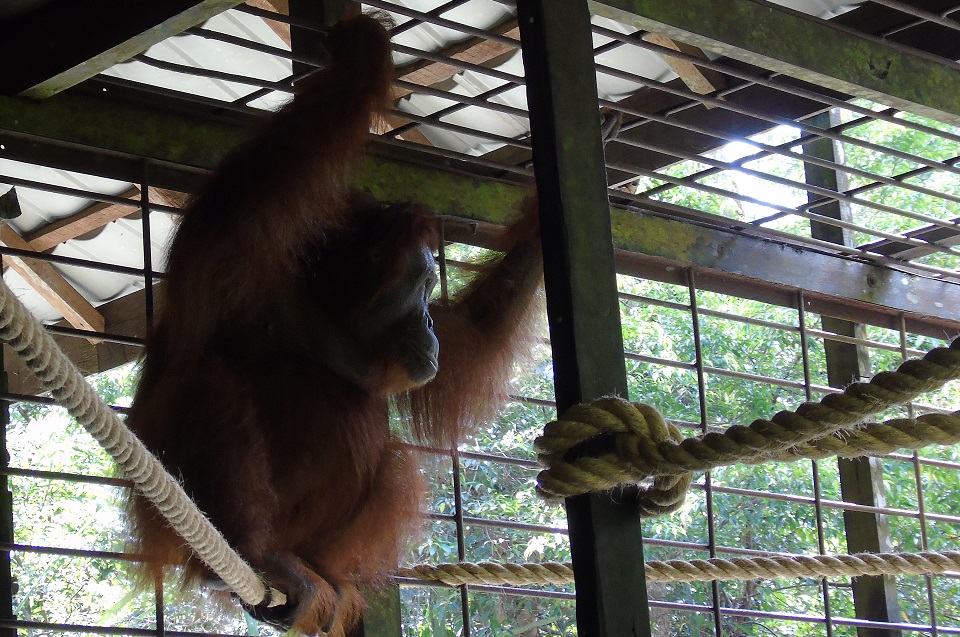
They walked from camp through the forest to the feeding site, where supplementary fruit is provided. Dominant male, Bangkal came to feeding along with female and infant orangutans; Ilik and Izzy; Hola and Happy; Ebony and Ekon (photos below); and Passion and Paris. Max was also seen with her newborn infant, now named Monti and they seemed well.
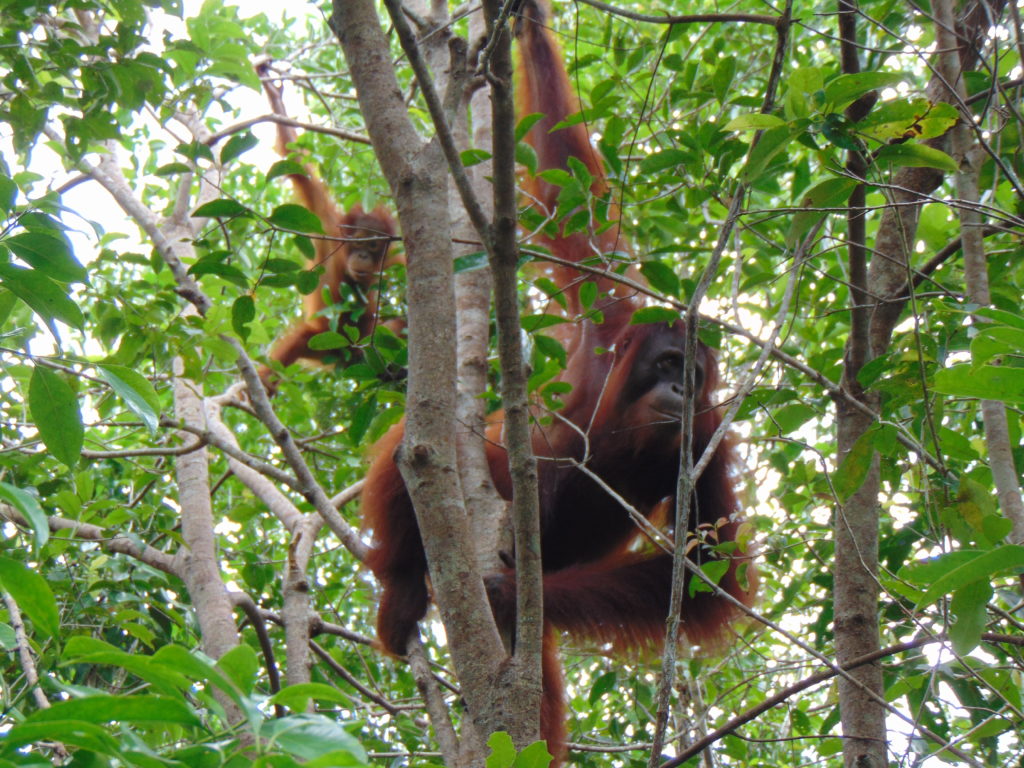
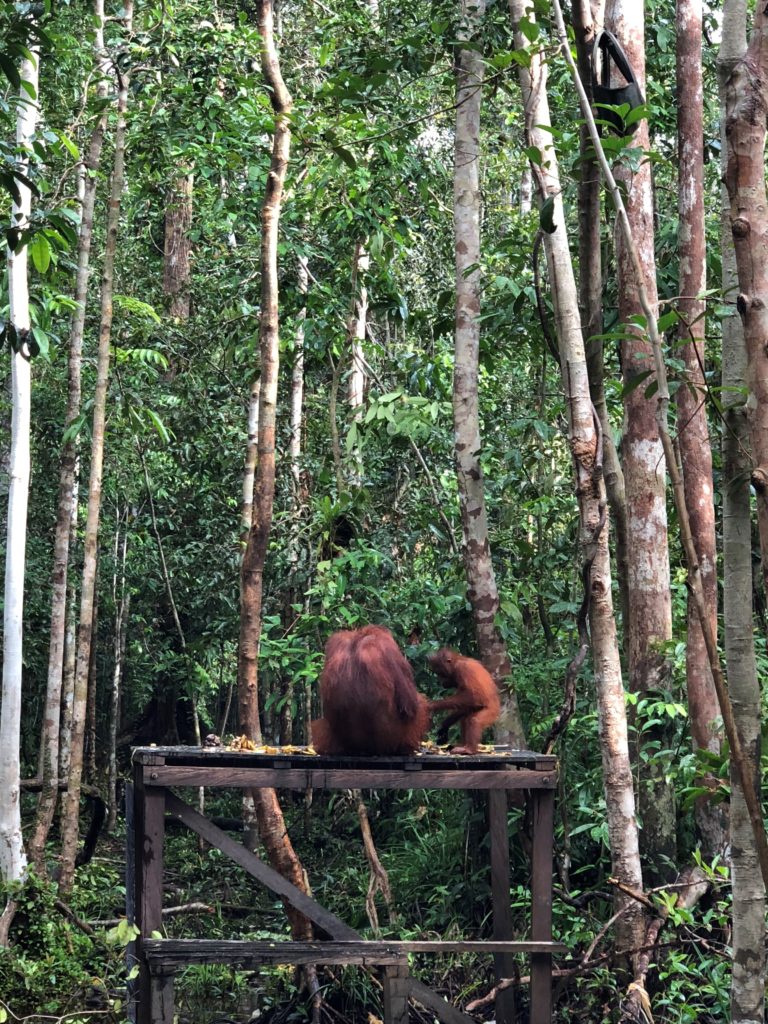
A few days later they went to Camp Buluh, to check on orphan orangutans Okto and Syifa. Okto had injured one of his fingers a few weeks ago but after receiving treatment the inflammation has reduced and is healing well.

Both Okto and Syifa very active and enjoy playing together. Okto was given a final anti-inflammatory injection and both orangutans received their multivitamins.
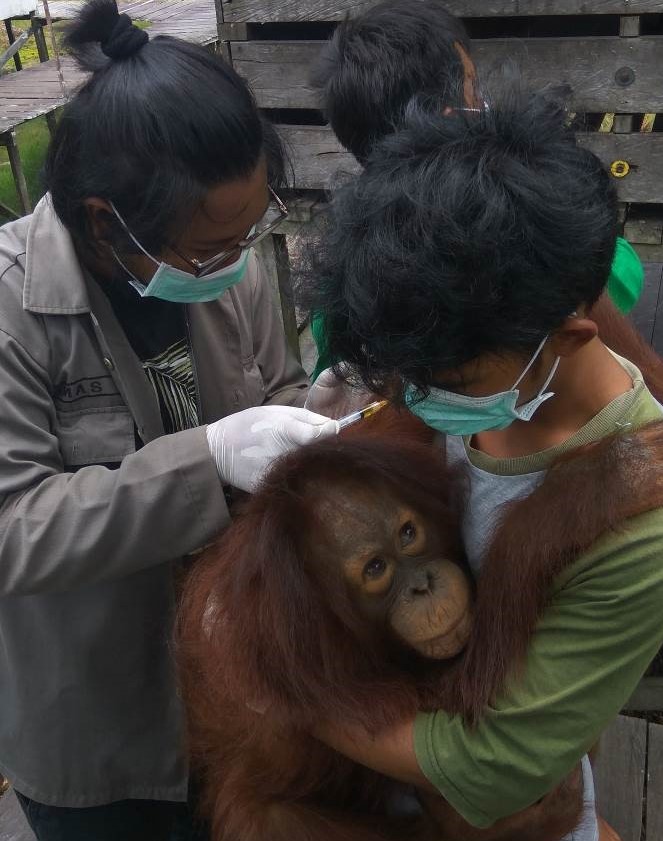
Conditions are very dry at present and so our guard post staff are vigilant and on alert for fires. All the guard posts are equipment with fire-fighting gear and our staff are trained enabling them to respond quickly and effectively to extinguish fires.
Please help us to keep forests standing and orangutans in the wild. You can support our work by donating or adopting Okto or Mona.
Wild orangutan rescued and moved to safety
When our staff arrived at the oil-palm plantation they found the orangutan in an area of forest, on the riverbank of the plantation. We had been called in to help by BKSDA SKW II Pangkalan Bun (government agency for wildlife) who had received reports from an oil-palm plantation of an orangutan in their plantation. It was decided to capture the orangutan and move her to the protected Lamandau Wildlife Reserve, to avoid potential conflict.
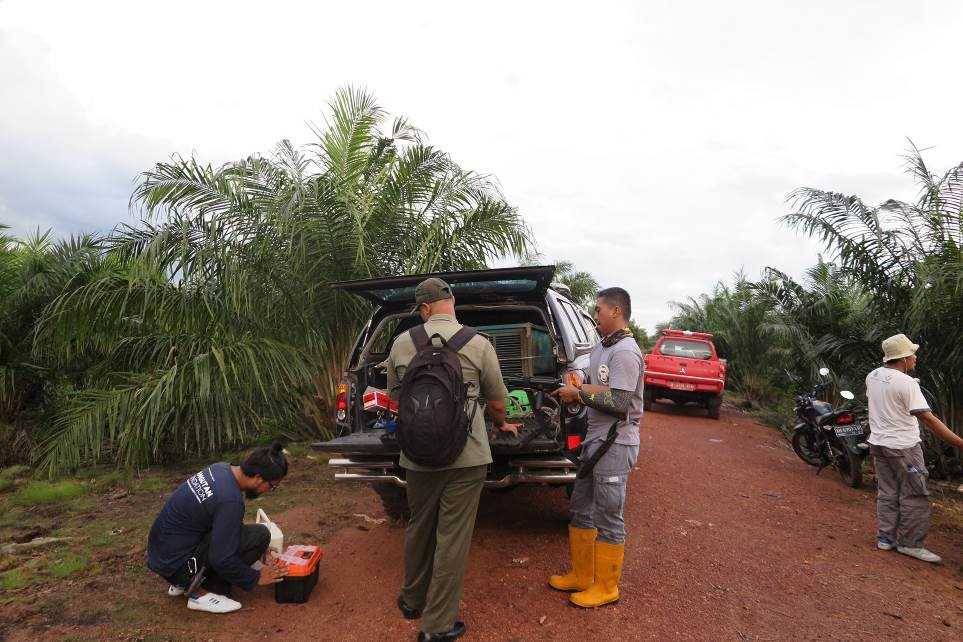
The orangutan, who they identified as female, had made and was resting in a nest. This made it easier to dart her as she wasn’t moving.
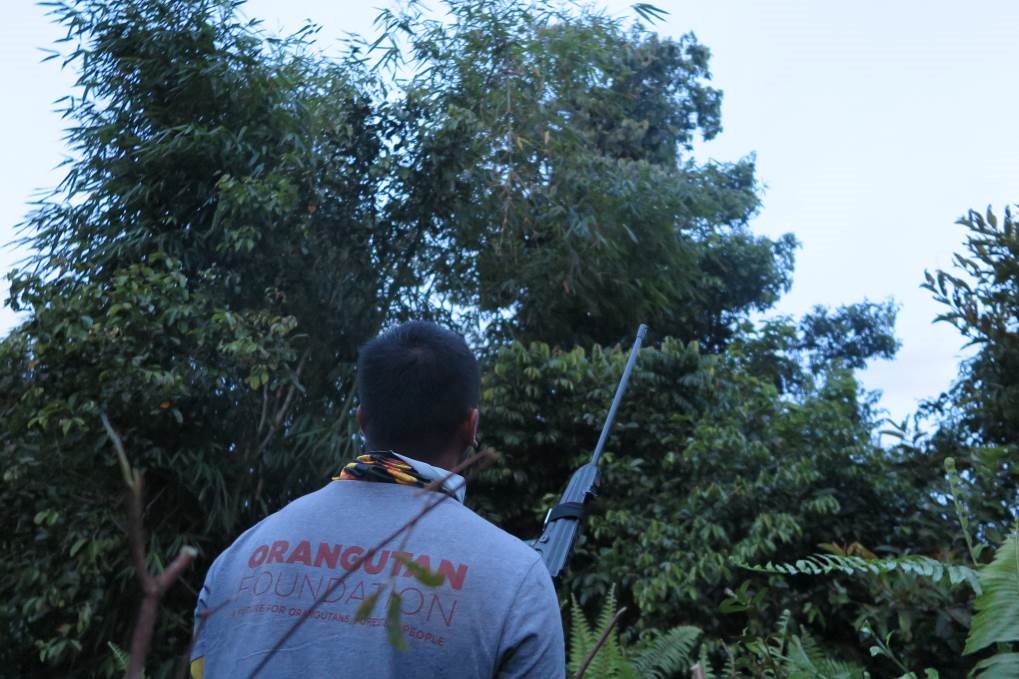
What our staff hadn’t anticipated was that she might just remain where she was and fall asleep, making it very difficult to then rescue her. This is just what happened!
One of our rescue team staff, Mr Nasibah, also an expert tree climber, shinnied up the tree to the nest. With huge effort he managed to lower the unconscious orangutan out of her nest. Our staff on the ground, used netting to catch her, as she fell to the ground.
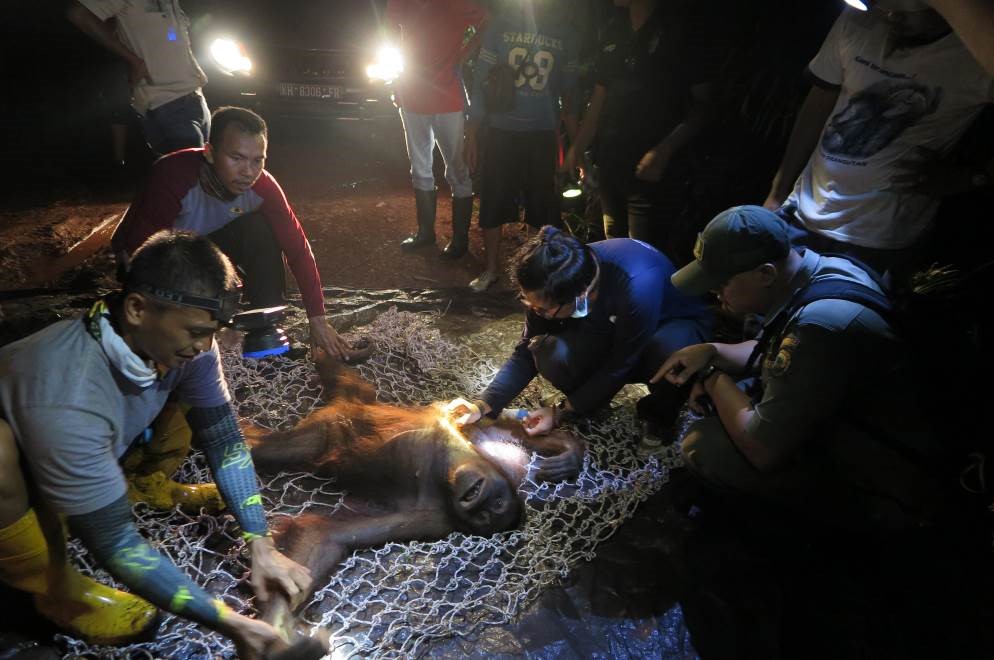
She was quickly transported to an open area where our vet Dr Dimas, examined her. Apart from a small scratch to her chest, she was in full health, weighing 45 kilos and was thought to be around 18 years-old. The scratch was cleaned and injected with long-acting antibiotics to prevent infection.
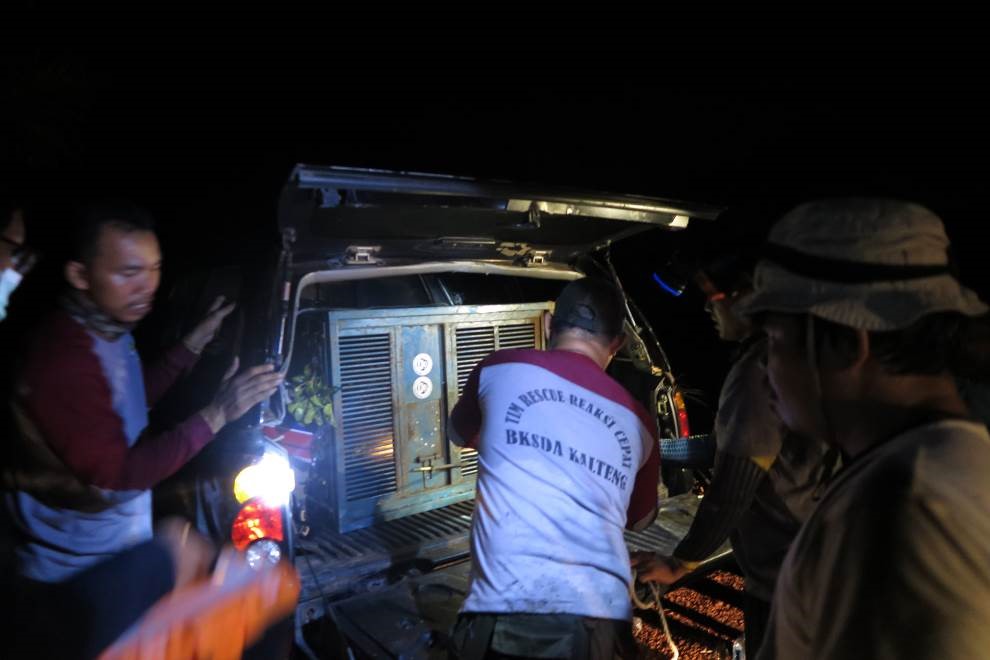
Two days later the orangutan was released in the Lamandau Widlife Reserve, on the opposite side of the river from Camp JL. We protect this forest reserve with guard posts and regular forest patrols to prevent and deter illegal activities.

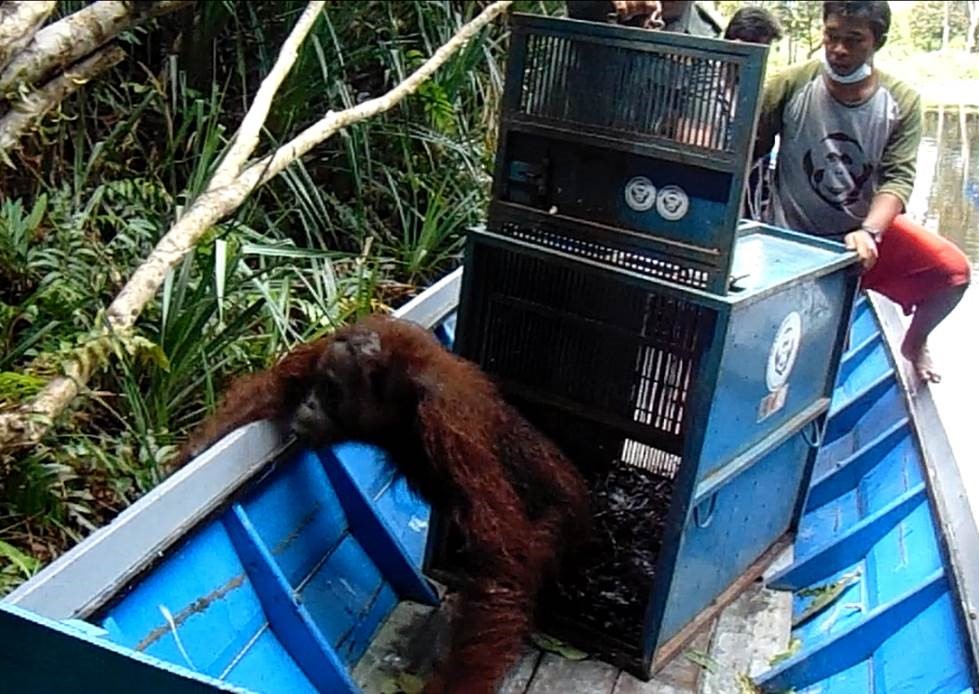
As soon as the transport cage door was opened she actively climbed into the nearby trees and disappeared into the forest.This, we hope, is her last encounter with humans.

The Lamandau Wildlife Reserve totals 158,144 acres of tropical forest and is home to a population of more than 500 orangutans. Half of these were reintroduced or translocated and given a second chance of survival in the wild. We must make sure they are stay safe. Please donate to our urgent appeal – DONATE TODAY
Vet treats orangutans but fires are causing concern
Our Vet, Dr Dimas, has been treating one of the young orangutans in our Soft Release Programme for a dry scalp. Dimas, has been applying a moisturising ointment and our staff will continue with this treatment.
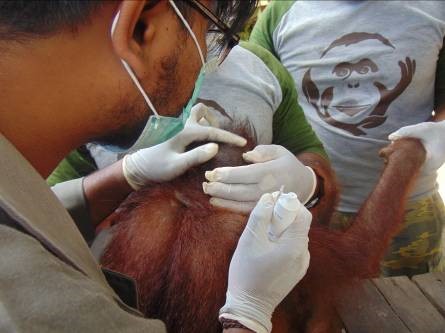
All our young orphaned orangutans were also given vitamins and medication to prevent parasitic worm infections.
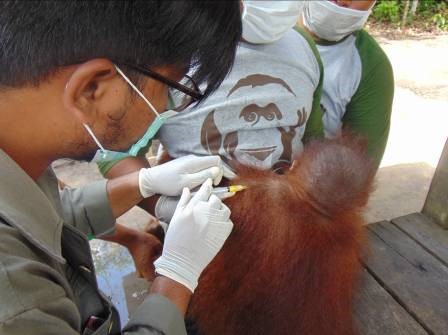
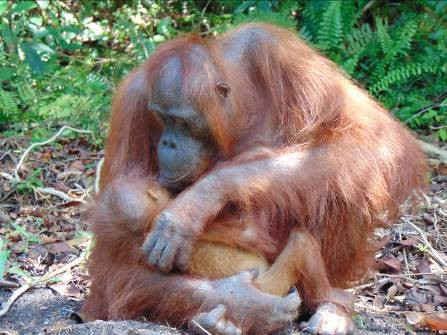
While going from Camp Siswoyo to Camp JL within the Lamandau Wildlife Reserve, Dr Dimas and Azhari (Orangutan Reintroduction Manager) had to use a kelotok boat (flat bottomed) instead of a speedboat because the water level is getting lower. The dry season seems to have come early this year to Central Kalimantan, with very little rain.
There are worrying reports of more fires, right on the boundary of the Reserve. We'll keep you updated on this situation.
Please click here to donate to our work.
Thank you,
Orangutan Foundation
Baby orangutan born
We are delighted to announce the arrival of another baby orangutan born into the protected Lamandau Wildlife Reserve, Indonesian Borneo. Our staff believe the orangutan was born on 26th January. Mother, Holahonolulu (Hola for short) was seen with her new infant at Camp Gemini's feeding site. We think the father is likely to be Bangkal, the dominant male, as they were seen mating on several occasions.
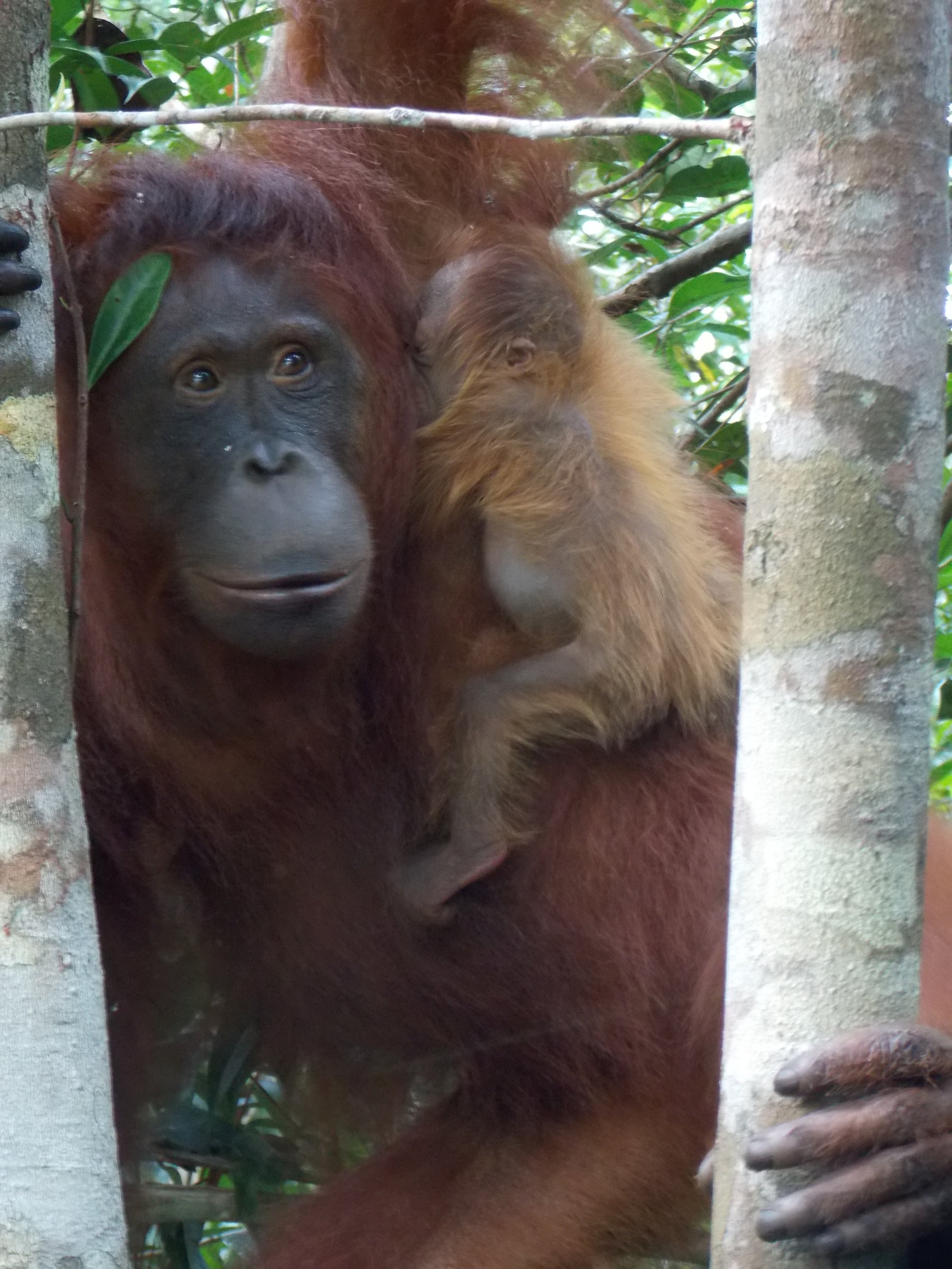

Both Hola and her baby looked healthy. Hola ate a lot of fruit, the extra energy needed for milk production. As yet, our staff could not tell what sex the baby was.
Hola was born in the wild in December 2004 and her mother was Huber. Huber was rehabilitated by OFI and was released into the Lamandau Wildlife Reserve in December 1999, but she has since passed away.
Our staff have yet to name Hola's new baby so we thought we would ask for your help. Send us your suggestions (leave a comment), it must start with an H and be a unisex name. We will decide on Monday 5th February.
Help us to ensure these orangutans remain in the wild and that their forest home stays protected. Click here to donate today!
Orangutan Foundation - a future for orangutans, forests & people
Vet's first orangutan rescue
The Orangutan Foundation is delighted to welcome Dimas Yuzrifar as its new vet, replacing Dr Steven, who has now returned to Bali. Being "thrown in at the deep end" is certainly how the first week has been for Dr Dimas! Last weekend we received reports of a wild orangutan in village forest. This was passed onto the government agency for wildlife, BKSDA SKW II Pangkalan Bun.
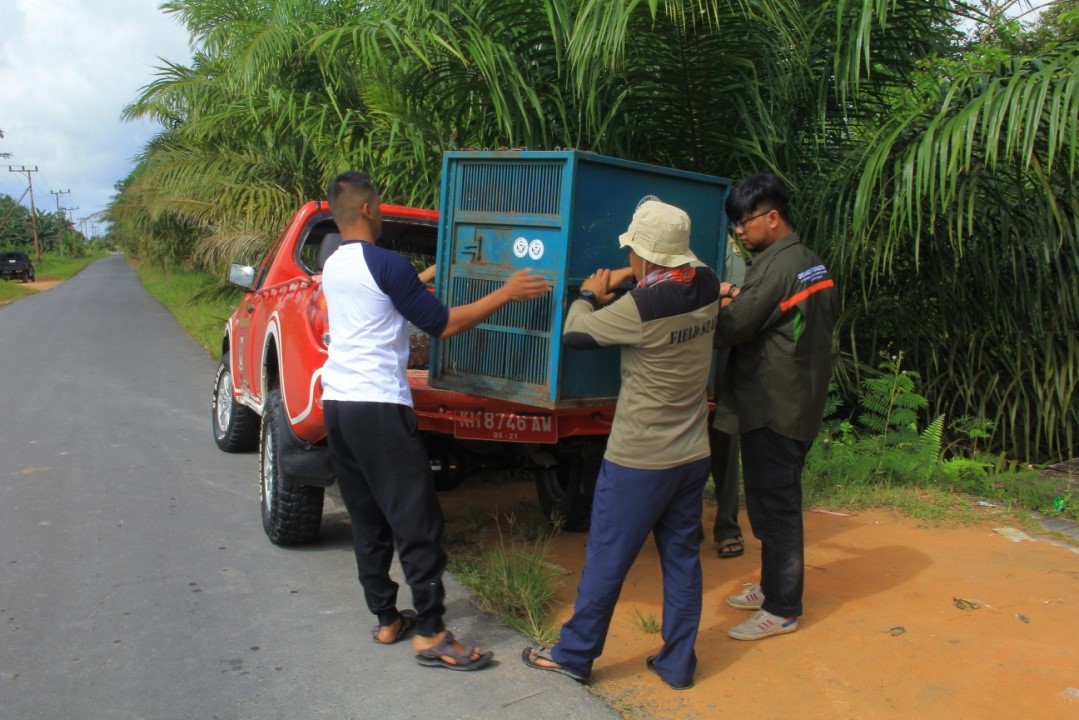
The orangutan was found close to oil palm, banana and rubber plantations owned by local residents. The villagers feared the orangutan would damage their crops and so BKSDA decided, in this case, to capture and move (translocate) the orangutan, to avoid any conflict arising. Dr Dimas managed to anesthetize the orangutan. After being caught the orangutan was identified as female with an estimated weight of around 25 kg. The next day after checking the orangutan was well and active she was released into the safety of the protected Lamandau Willdife Reserve.
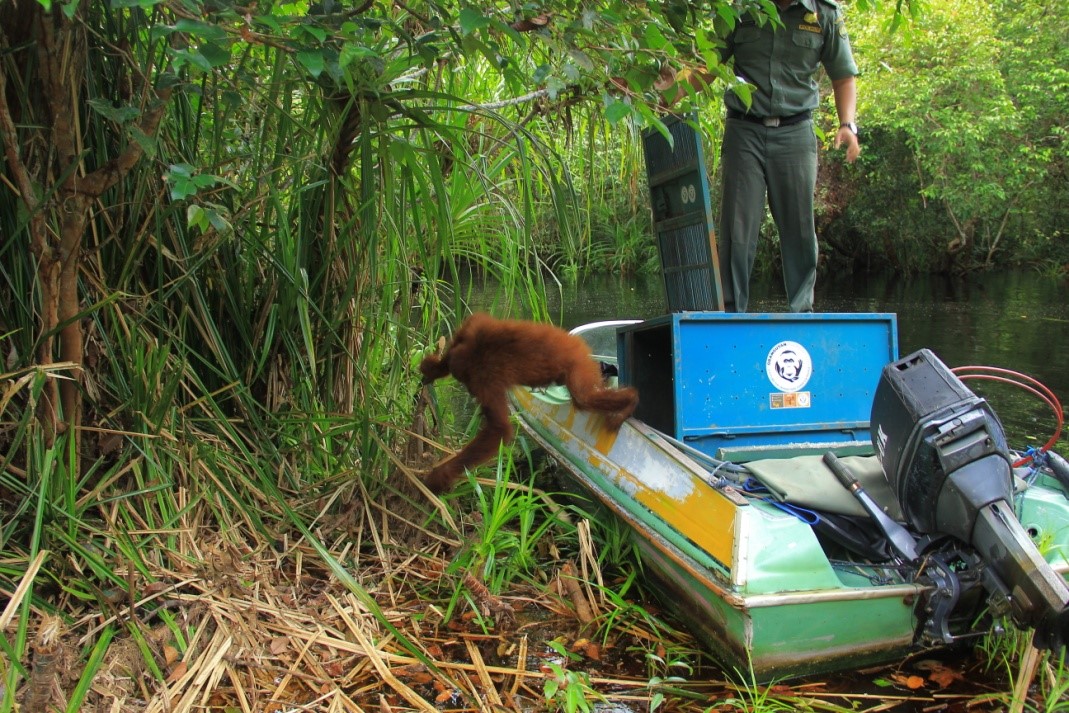
Watch this clip to see how quickly the orangutan leaves the transport cage and disappears into the forest.
After the busy weekend with the translocation, Dr Dimas also spent time meeting and checking up on the young orangutans in our release camps. Here's a clip of young Satria playing in his night-time enclosure.
Wonder what the next week will have in store?
Thank you for supporting our work.
Donate to help us keep the Lamandau Wildlife Reserve and its precious orangutans and wildlife protected. Click here to donate - thank you.
Orphaned infant orangutans "at home" in the forest.
“When Adib, an orphaned infant orangutan, arrived at the end of October he was afraid of climbing in the trees. Within two months he is much more confident and now seems very at home.” said Azhari Purbatrapsila, manager of the Orangutan Foundation’s Release Programme. In this blogpost, Azhari shares his observations of some of the characters in soft-release.
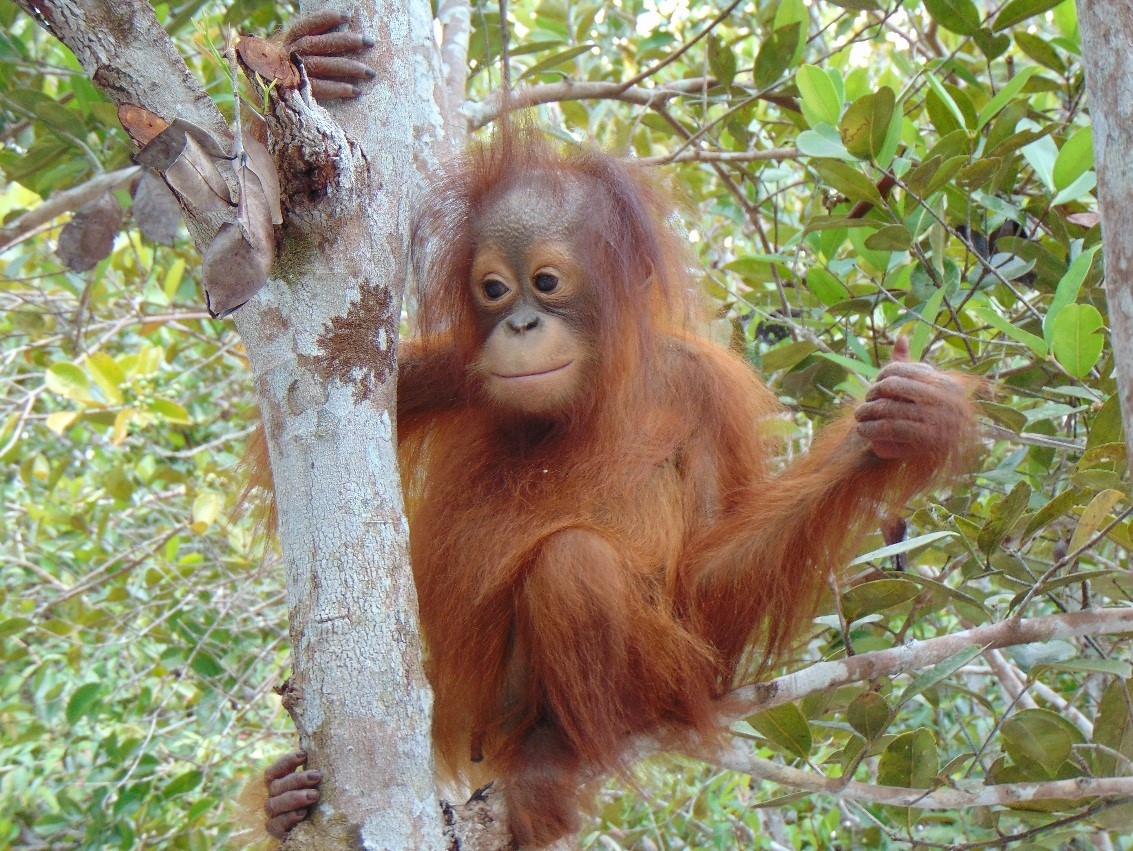
The Orangutan Foundation run 5 release camps within the Lamandau Wildlife Reserve, Indonesian Borneo. Here, infant orphaned orangutans undergo a soft-release process, allowing them time to learn the skills to survive in the wild.
Adib: He can climb high to the tree top. Sometime he plays with orangutans Mona and Timtom but he mainly loves to play alone since the other orangutans are bigger and stronger than him. (Watch Adib's first climb)


Mona: Mona is making great progress. Just after she moved out from her sleeping enclosure, Mona climbed a tree and straight away started bending the branches. She made a tiny nest. Not long after the nest had broken with the branches springing back to their original position. She still doesn’t have enough strength to break the branches and make a firm nest. But still, this is a really good improvement from her!
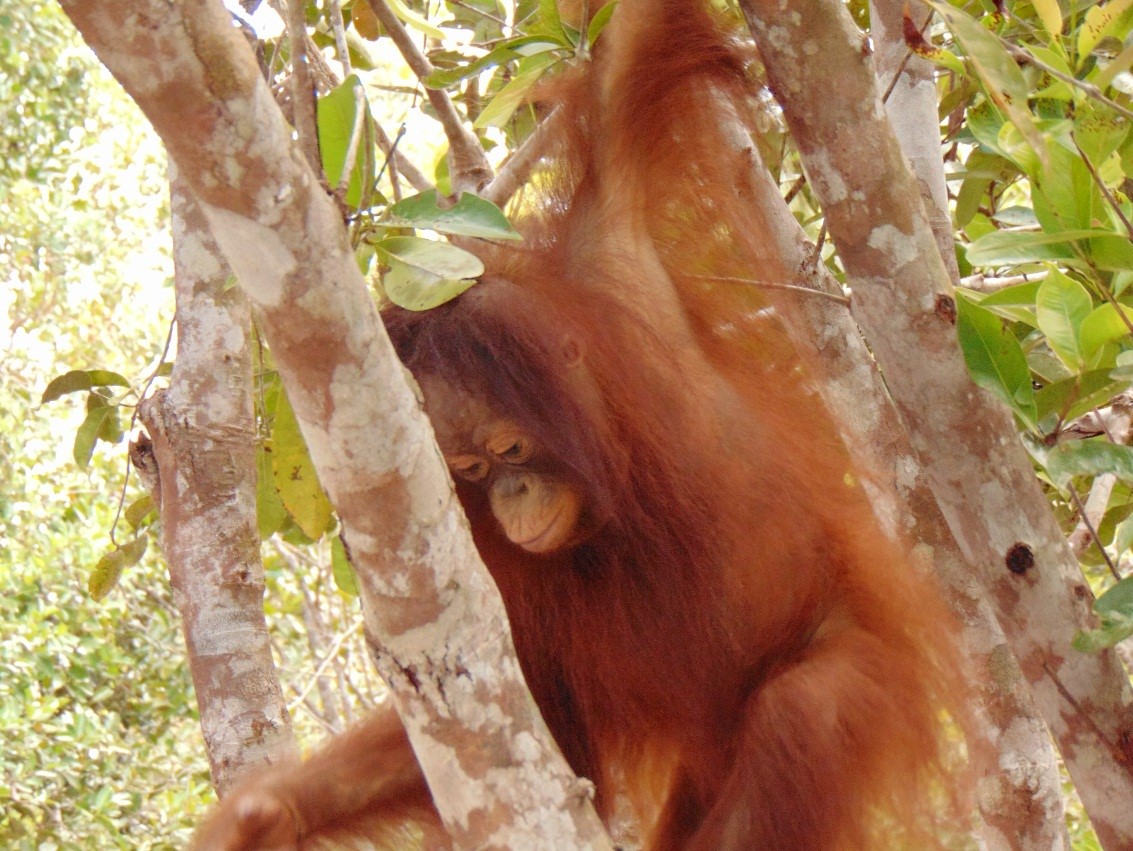
Timtom: Like Adib, Timtom likes to play alone but she will play will Mona or Adib. She plays in the lower tree branches, even though she can climb to the top. Being cautious, she never ventures far.

Boy & Nyunyu: Boy and Nyunyu are two of the biggest and strongest of the orphaned orangutans, which explains why they are best buddies. They are very active and spend almost all their time playing together so much so that it is often difficult to get them back in at night! An encouraging sign though.
Please donate to support our work helping these orangutans return to the wild. Thank you to all our members and supporters for their ongoing support.
An Orangutan Foundation snapshot - 2017
Here is a snapshot of the Orangutan Foundation’s year in the field, thanks to our dedicated Indonesian staff. Most importantly, thank you for your ongoing support. We truly could not do, what we do, without you. January: Miners evicted from the Lamandau Wildlife Reserve and mining equipment confiscated.
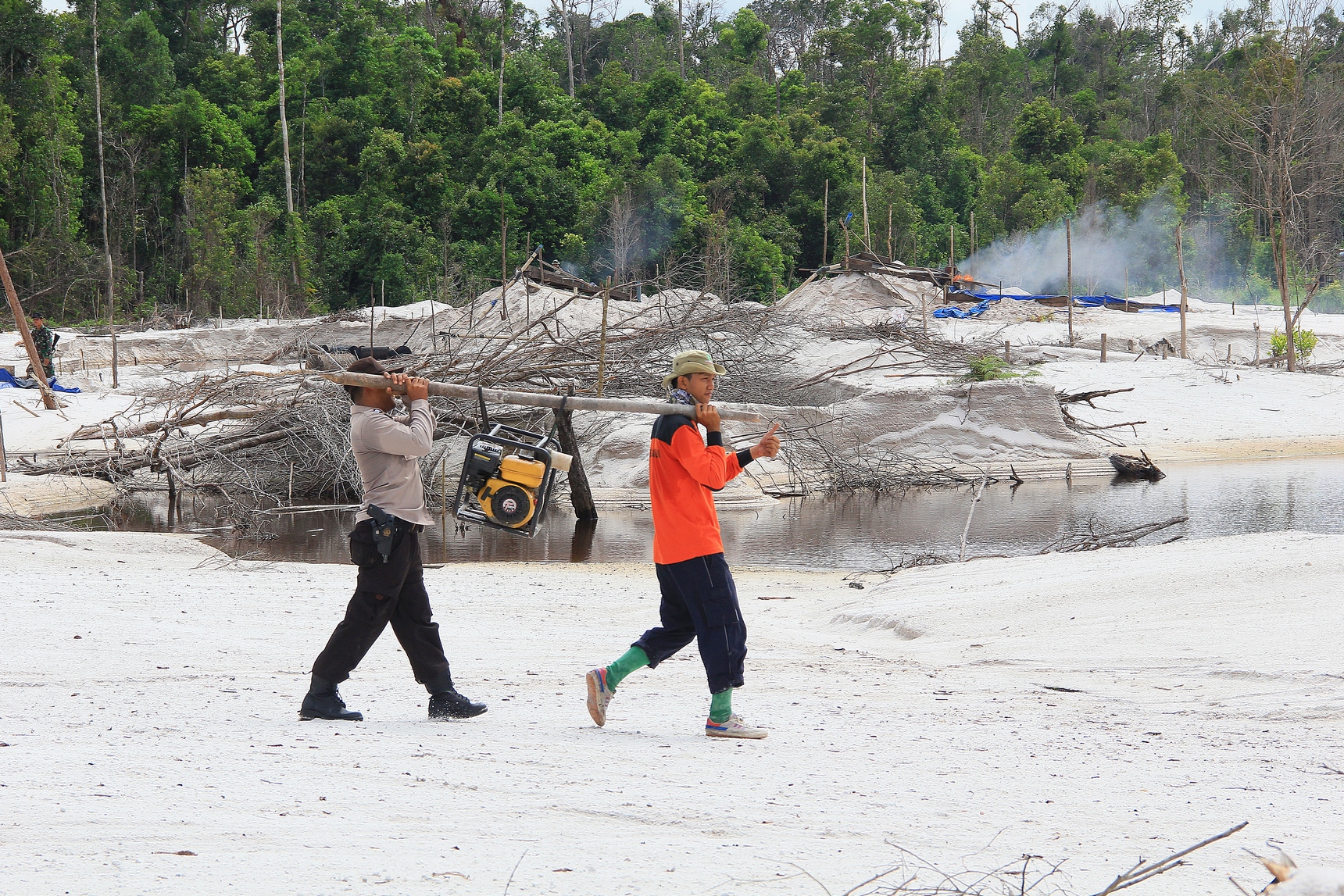
February: Attempts to restore sight to blind orangutan Aan sadly fail but her story galvanises support for her cause. We continue to care for Aan to ensure she has the best quality of life possible.
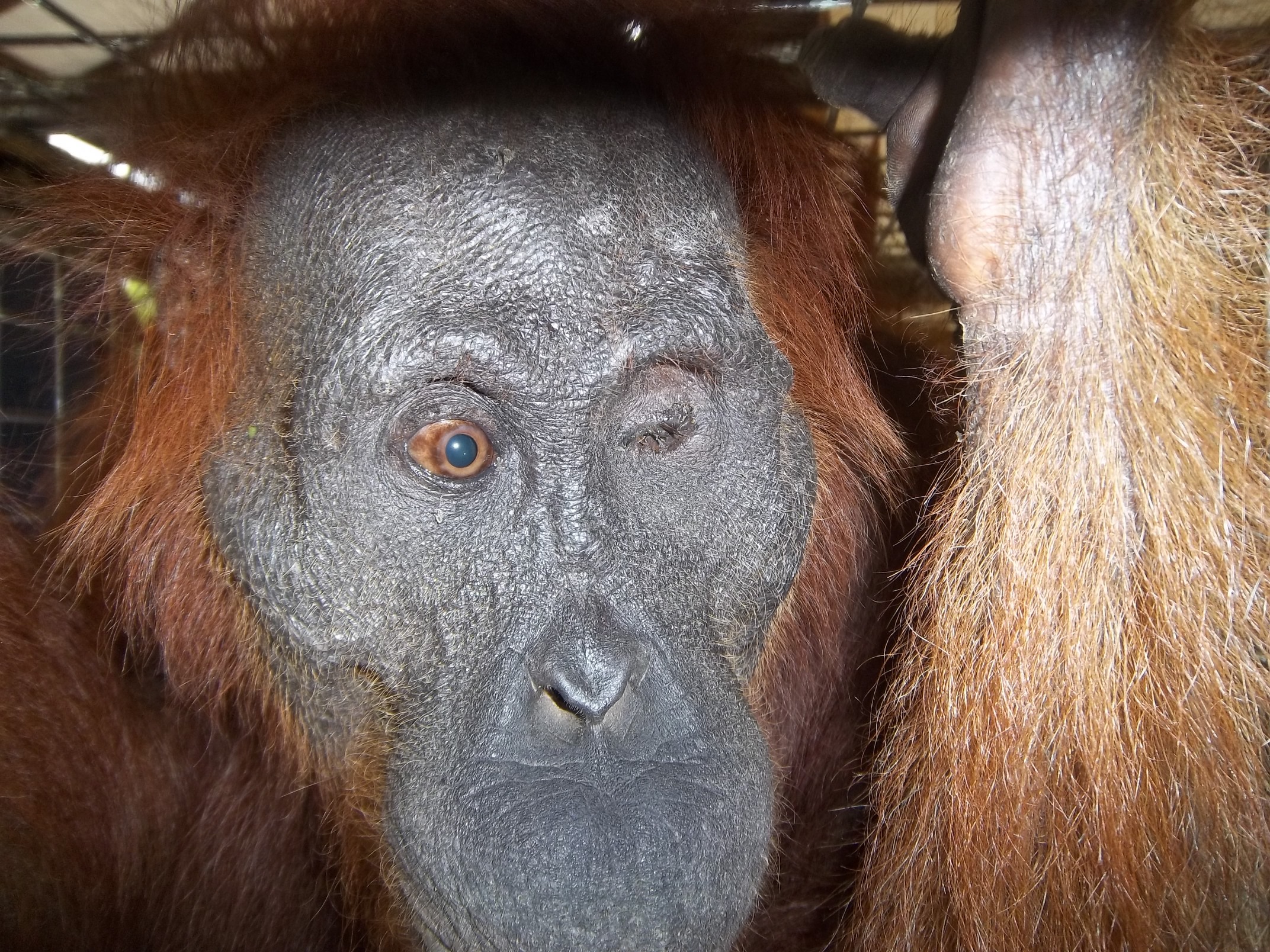
March: Infant orphans, Mona (top) and Nyunyu (below), are rescued and enter our Soft Release Programme, bringing it to 10 young orangutans being cared for.
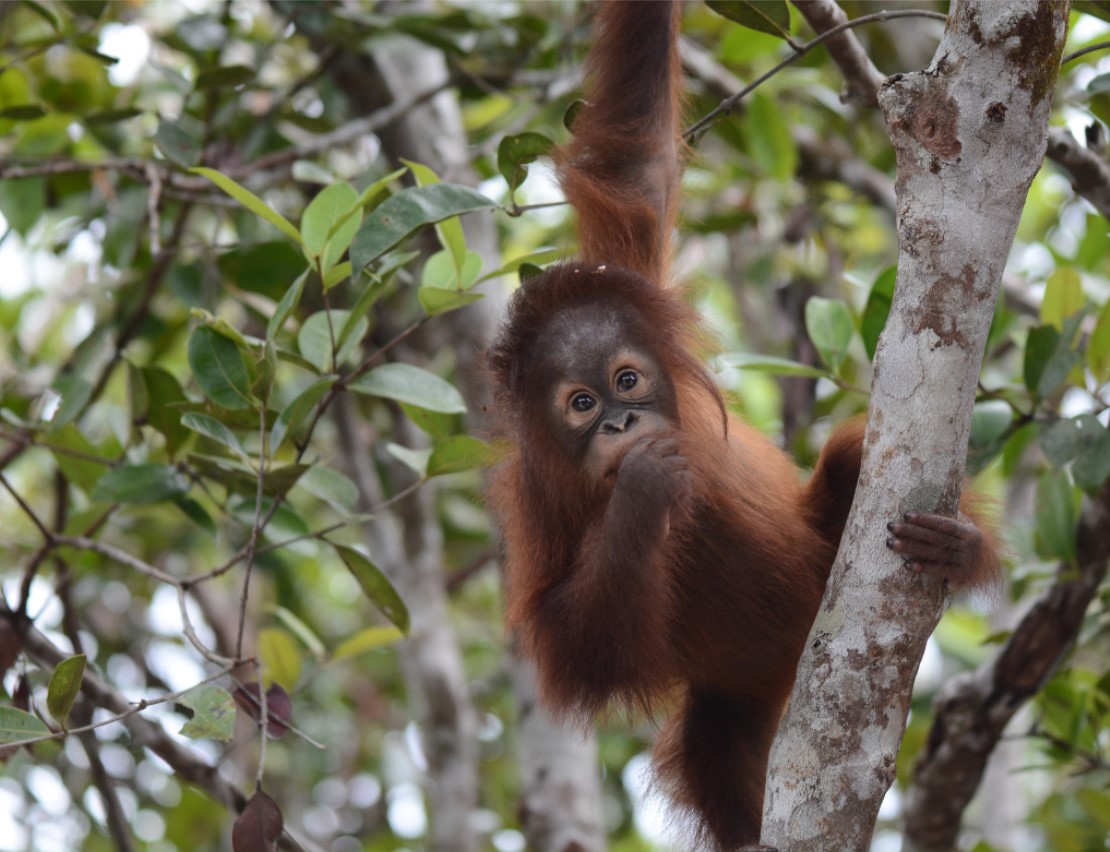
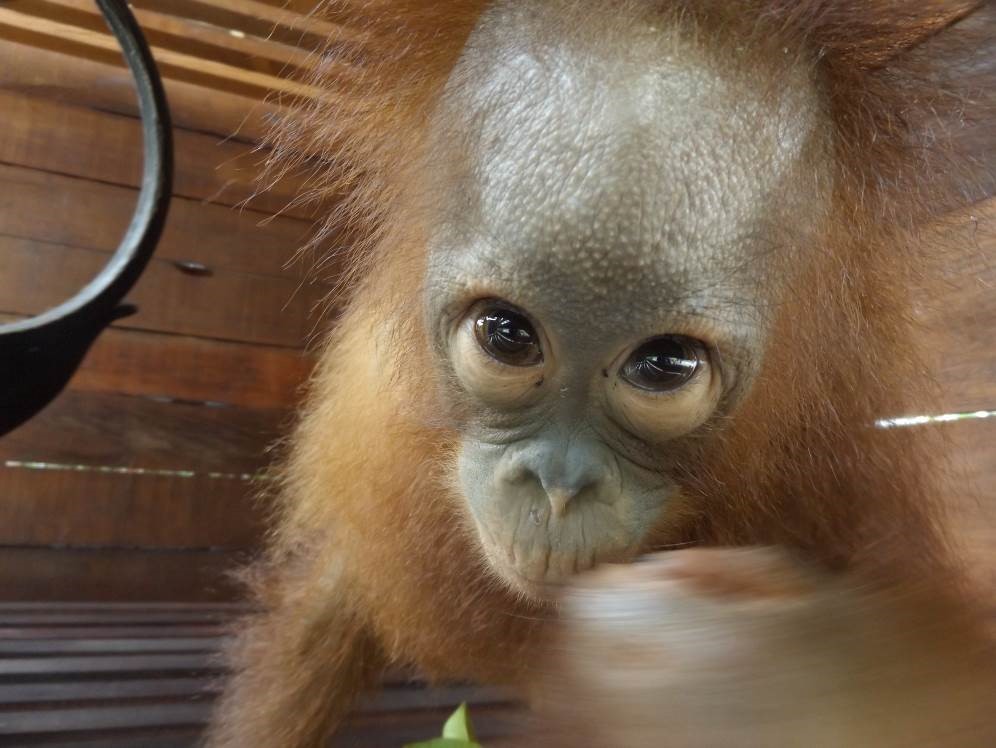
April: Orangutan Foundation, active on Earth Day, involving young Indonesian’s in cleaning up rubbish in their local environment.
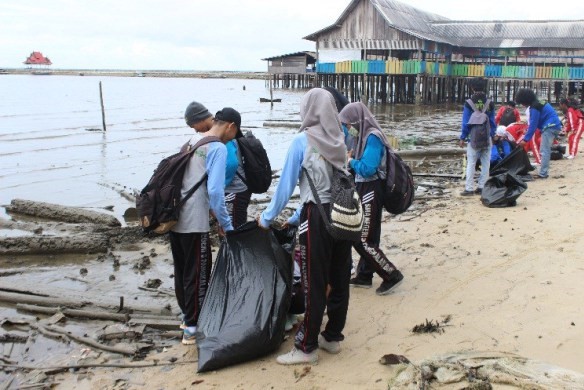
May: Publication of our new photo book promotes the wonders of the orangutan’s world and raises vital funds for forest restoration.
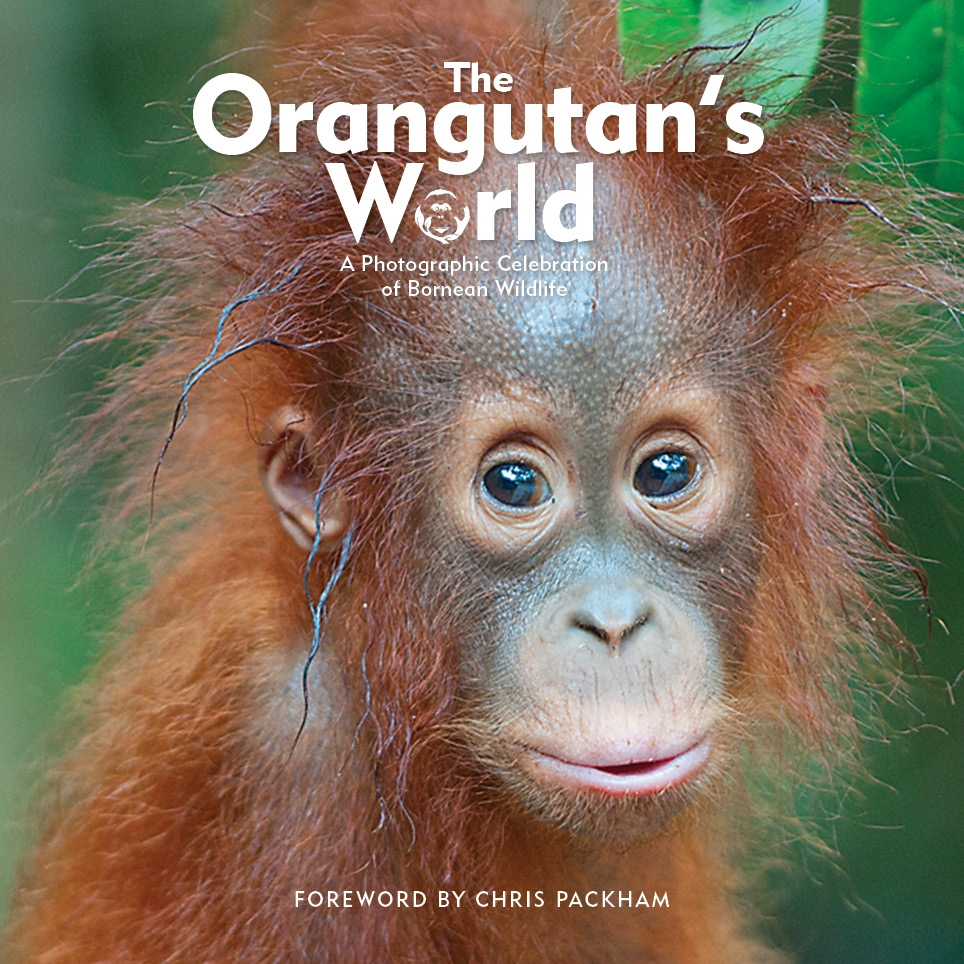
June: A new orangutan birth in Lamandau Wildlife Reserve. Venty shows off her new baby, Volvo.
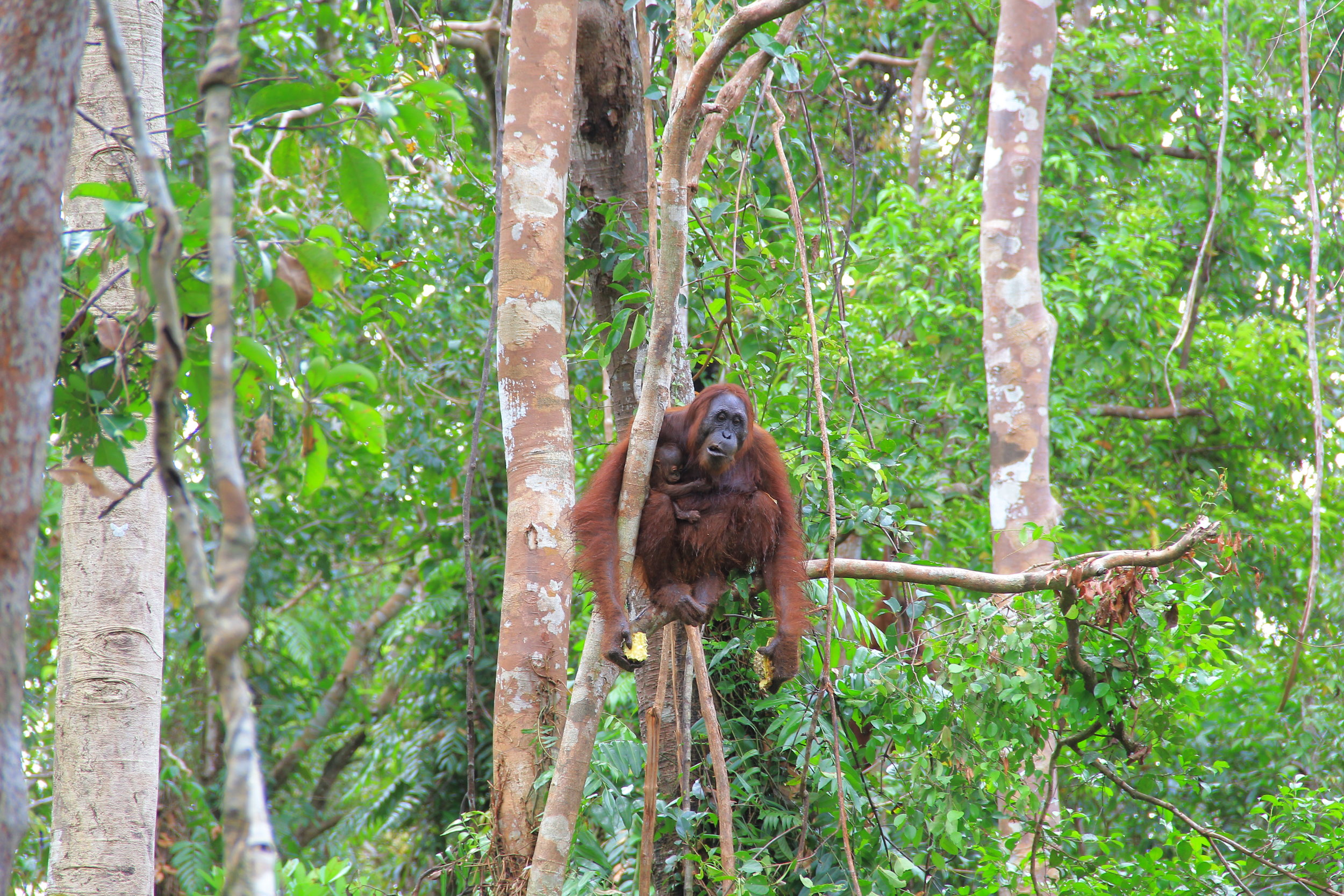
July: Another birth! Dedek gives birth to a healthy baby, named Dublin. Orangutans Jessica and Ketty, are released back to the wild!
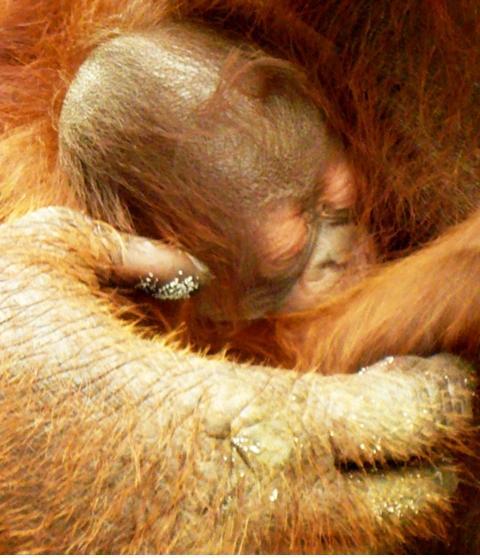
August: Orangutan Foundation staff help tackle fires and stop them spreading to the Lamandau Wildlife Reserve.
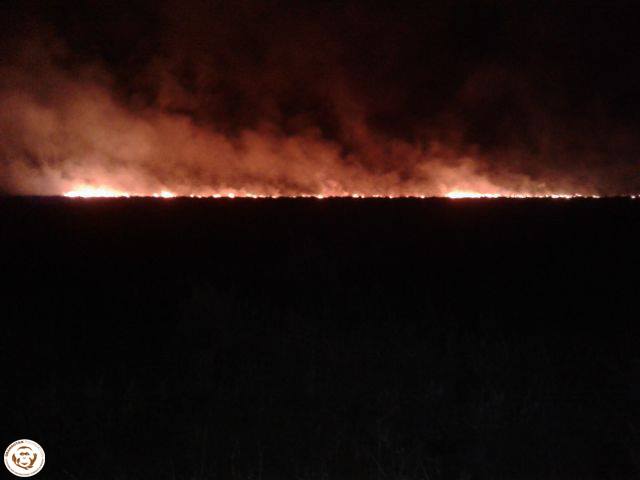
September: Orangutan Foundation Patrols in Tanjung Puting National Park remove and destroy illegal fishing traps, which also pose a threat to other wildlife species.
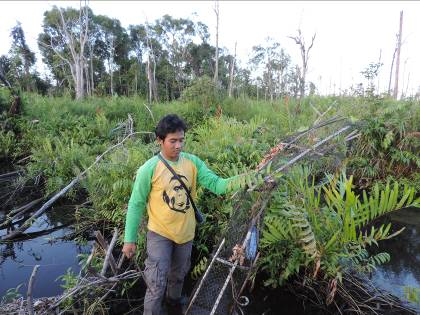
October: Bangkal, an ex-captive rehabilitated orangutan, reminds all who is King of Lamandau!
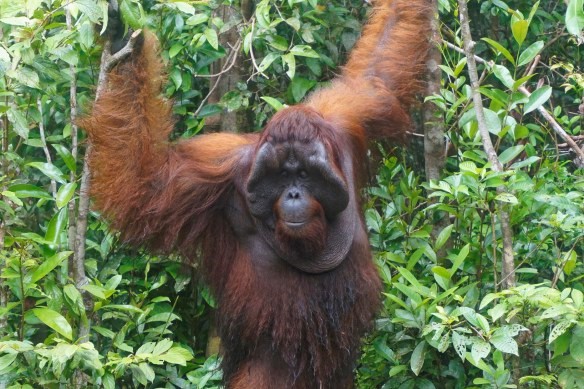
November: 22,000 tree saplings planted out in the Lamandau Wildlife Reserve in 2017
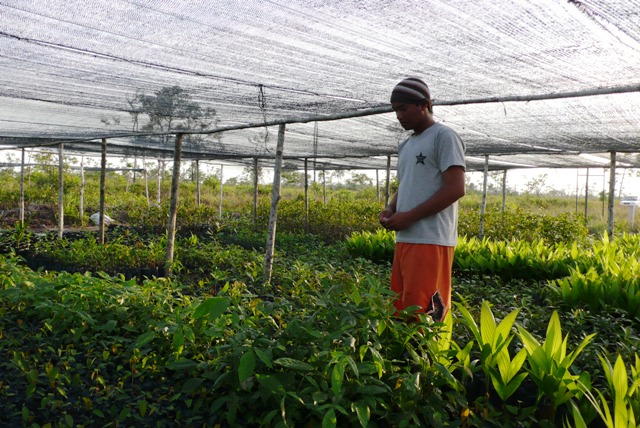
December: A wild female orangutan is rescued from a beach resort and translocated to the safety of the Lamandau Wildlife Reserve.
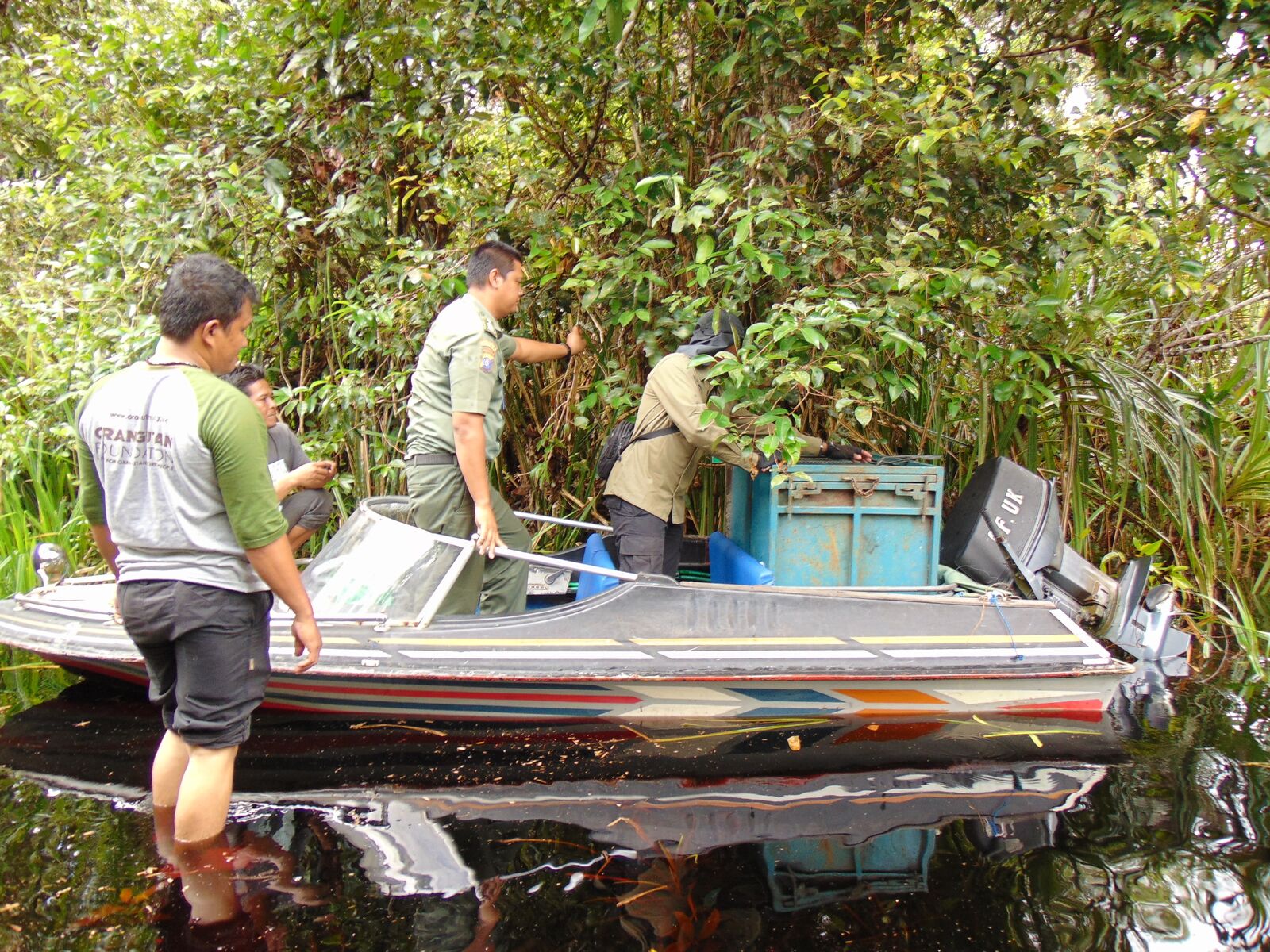
And to finish off our year here's Adib, the latest orphan orangutan to join us in November, making his first climb at Camp JL, in the Lamandau Wildlife Reserve.
DONATE to support our work

















